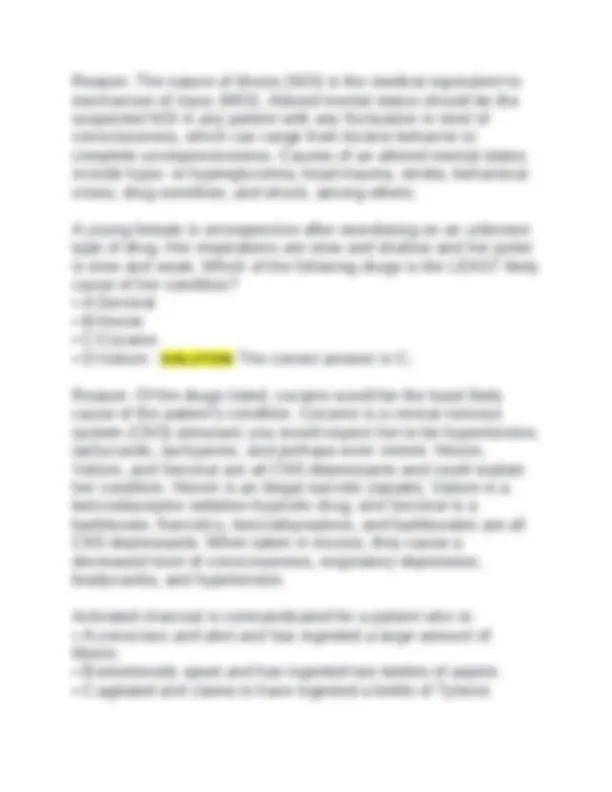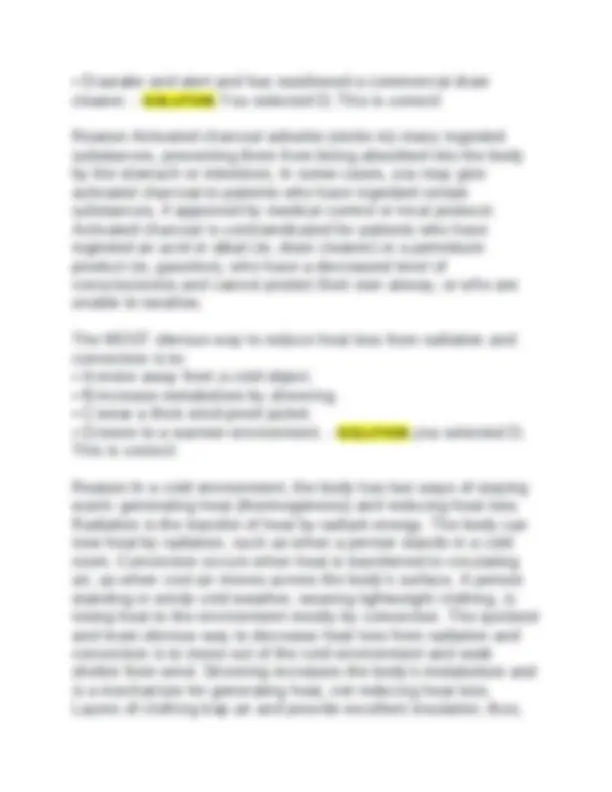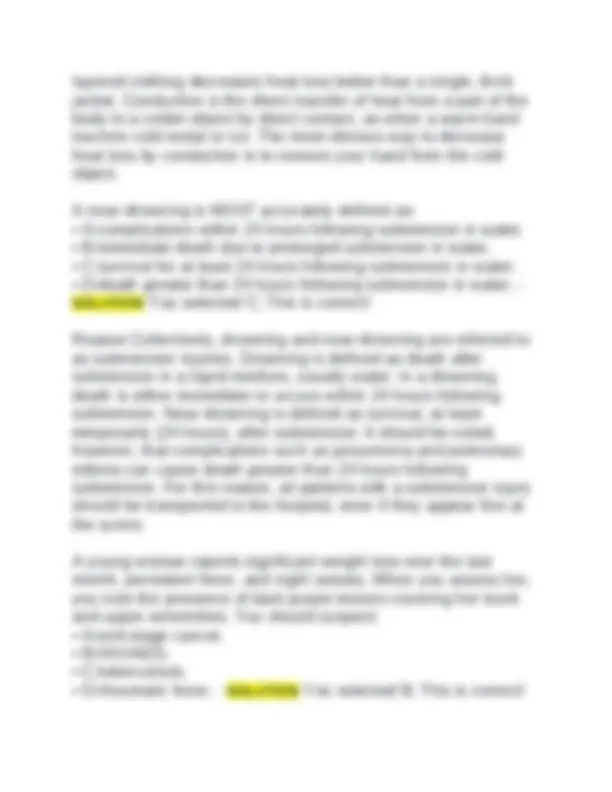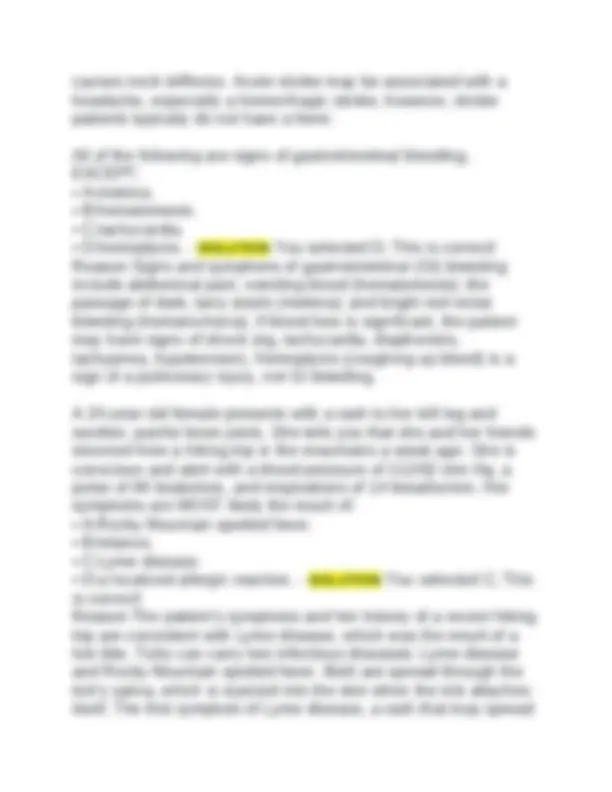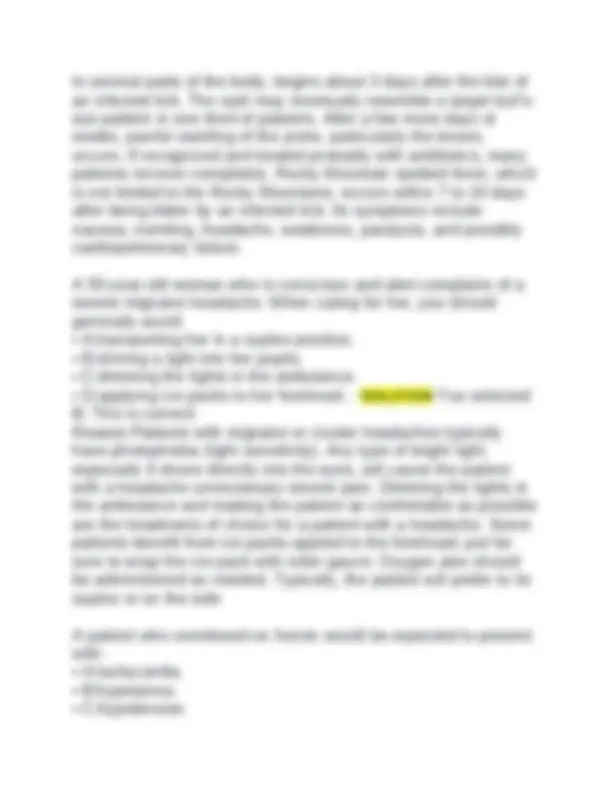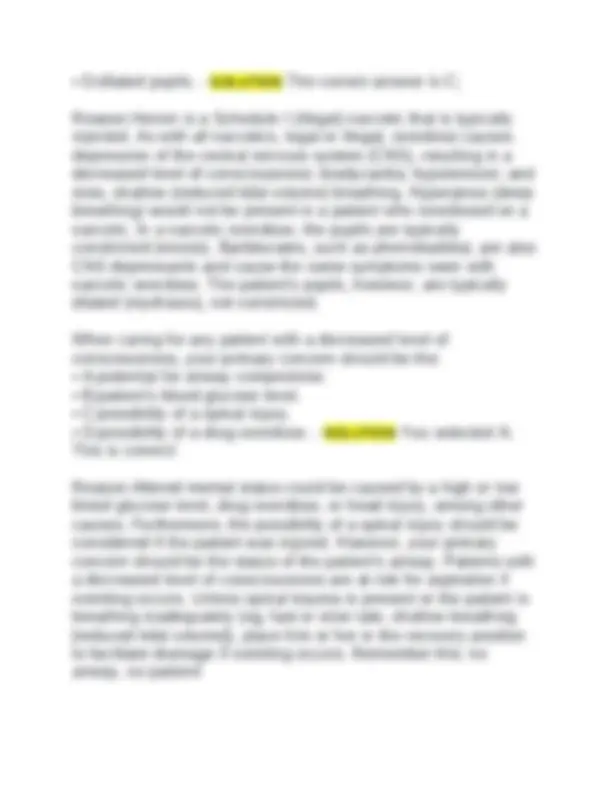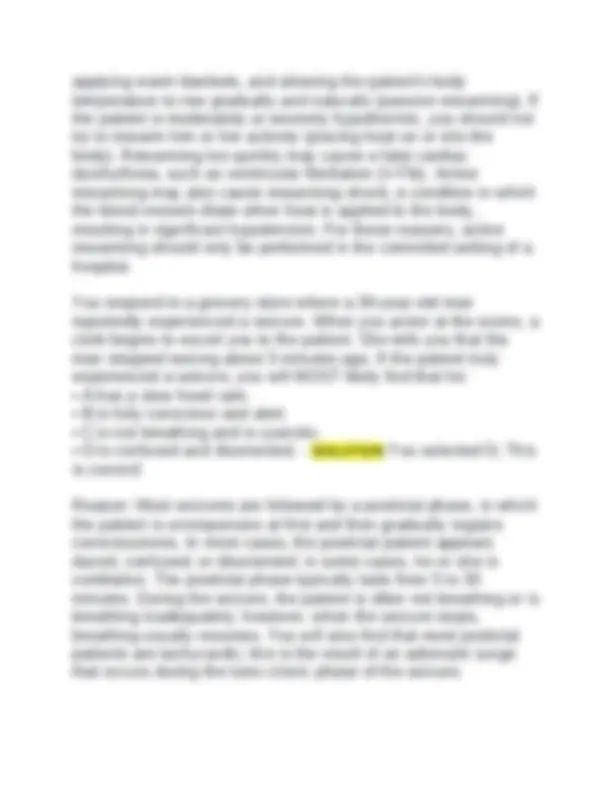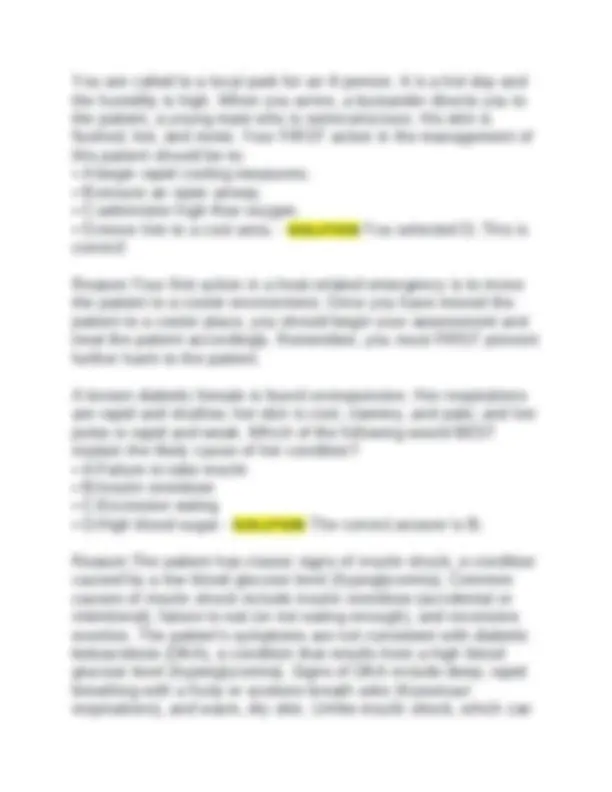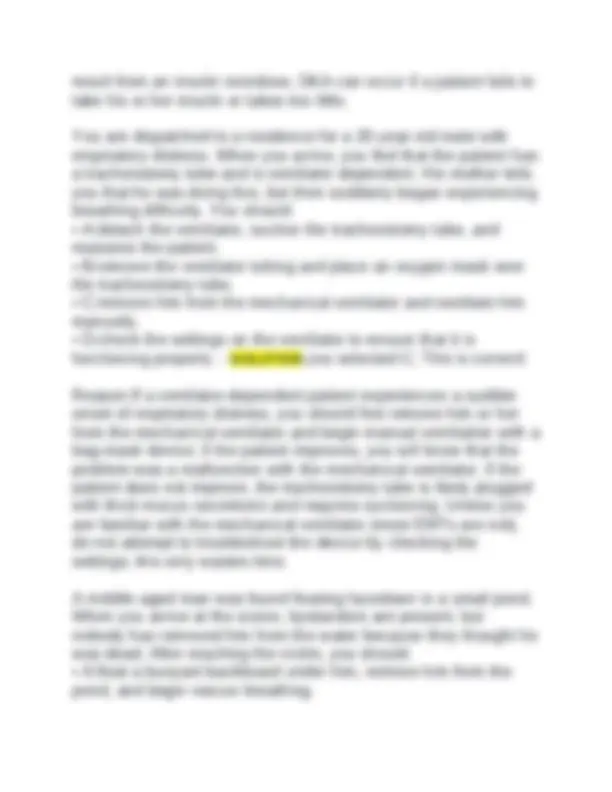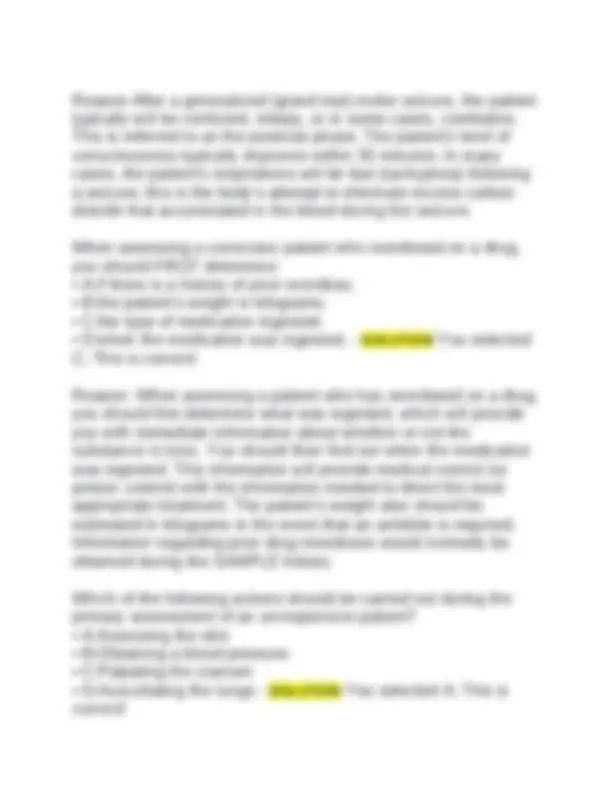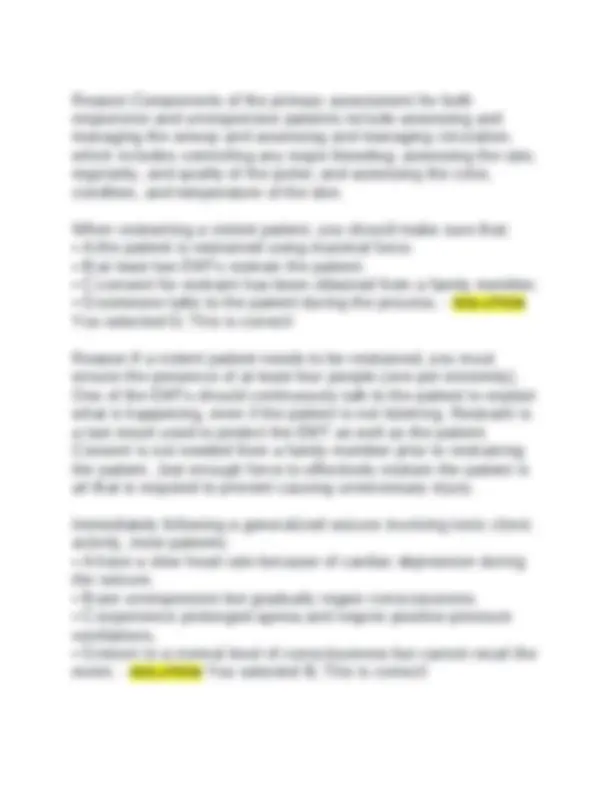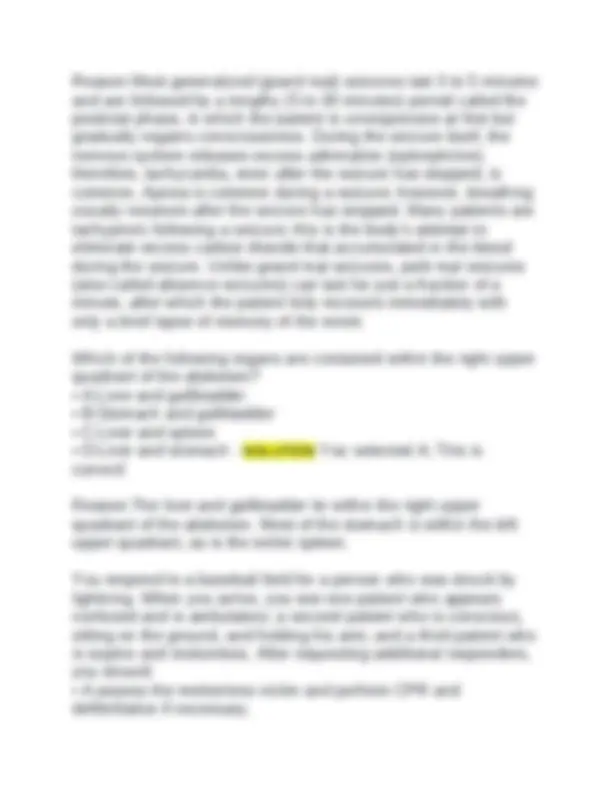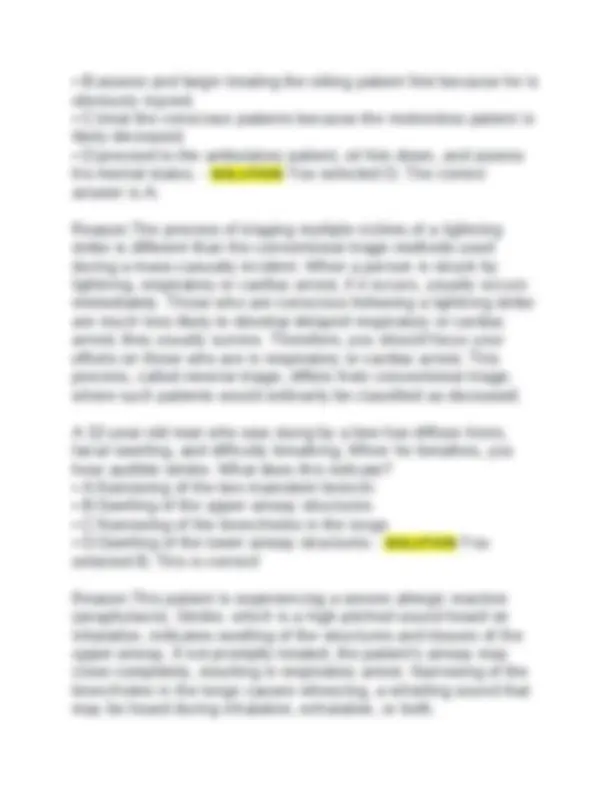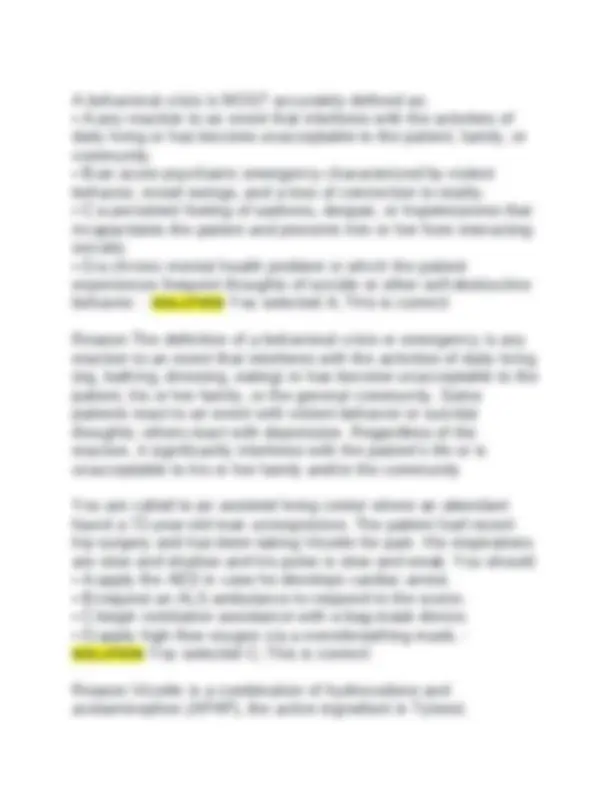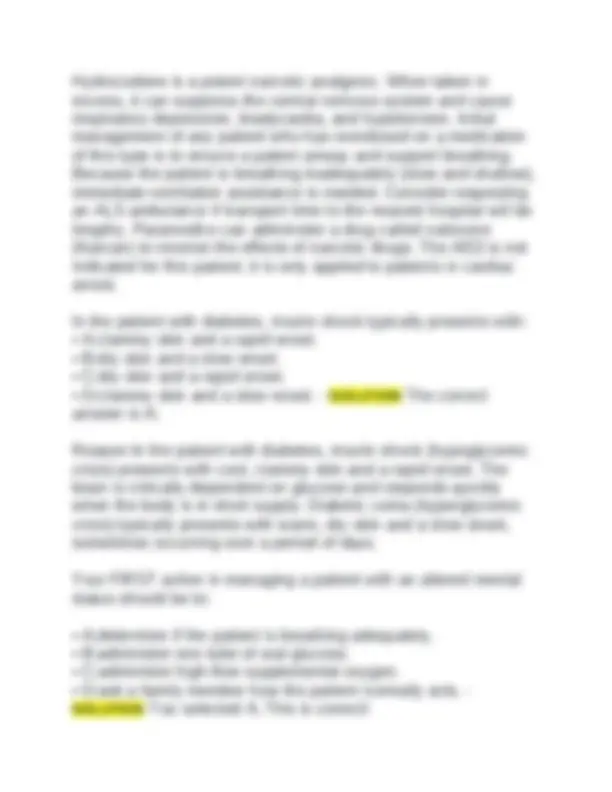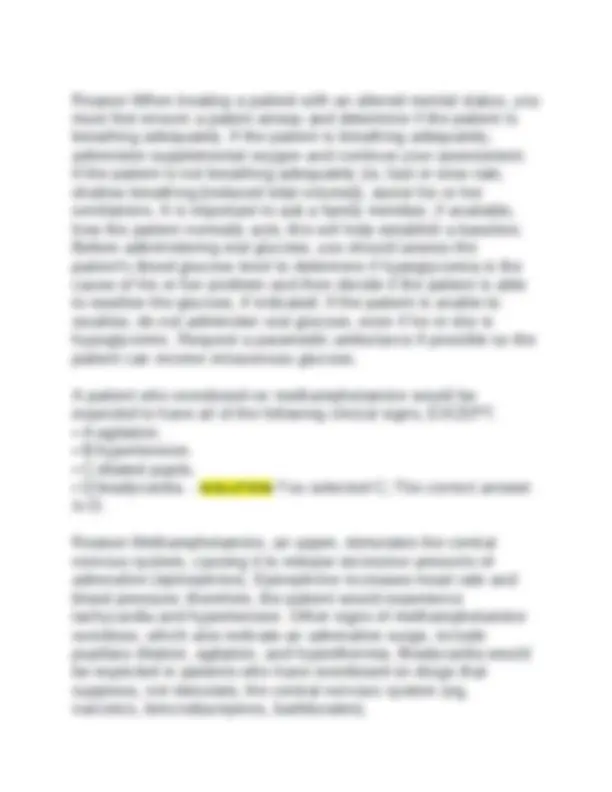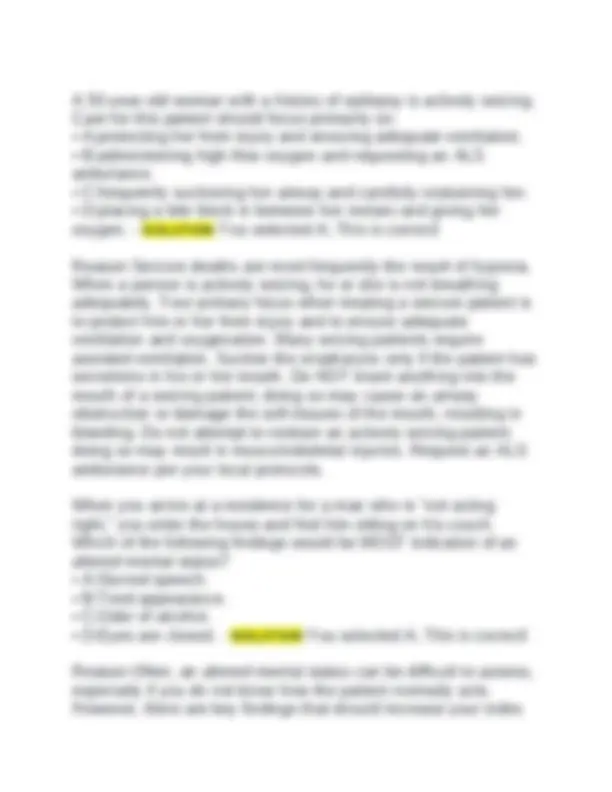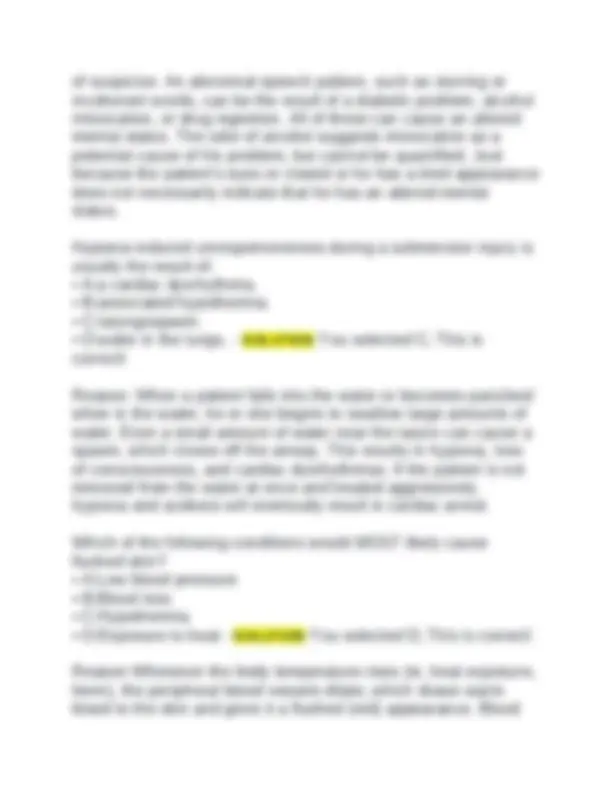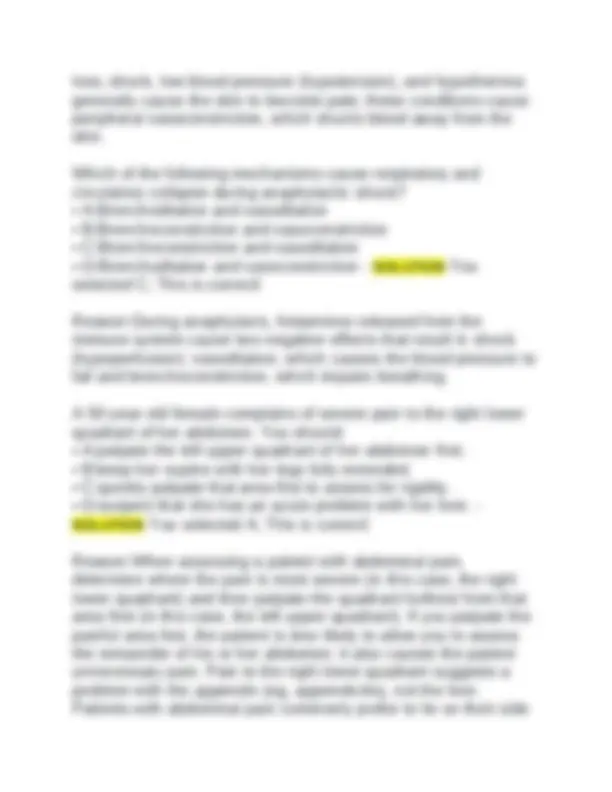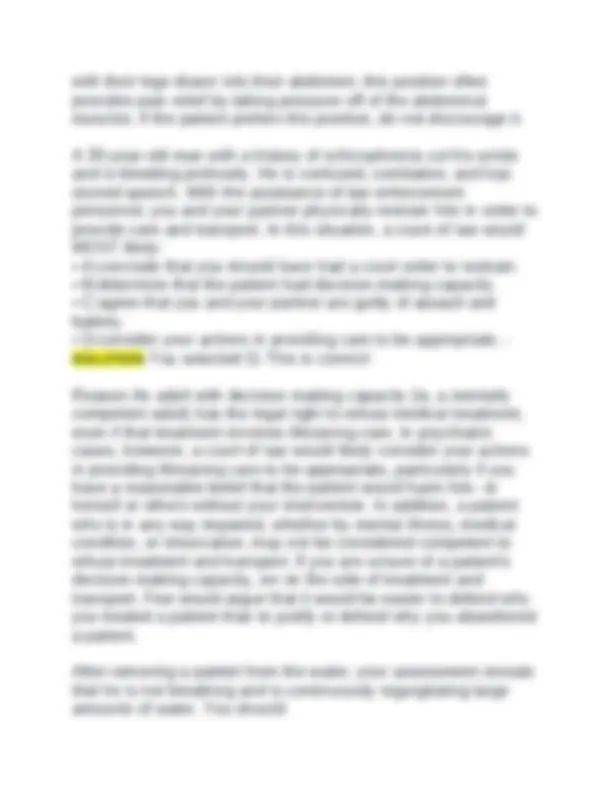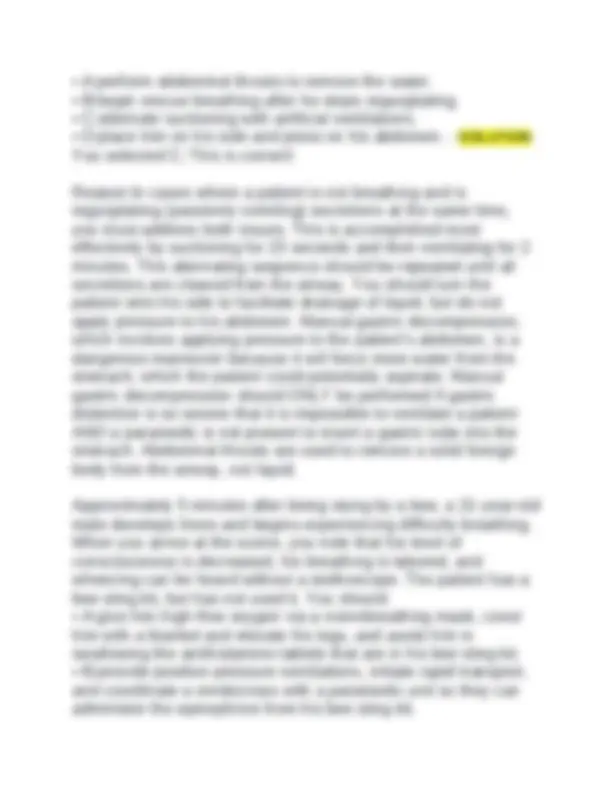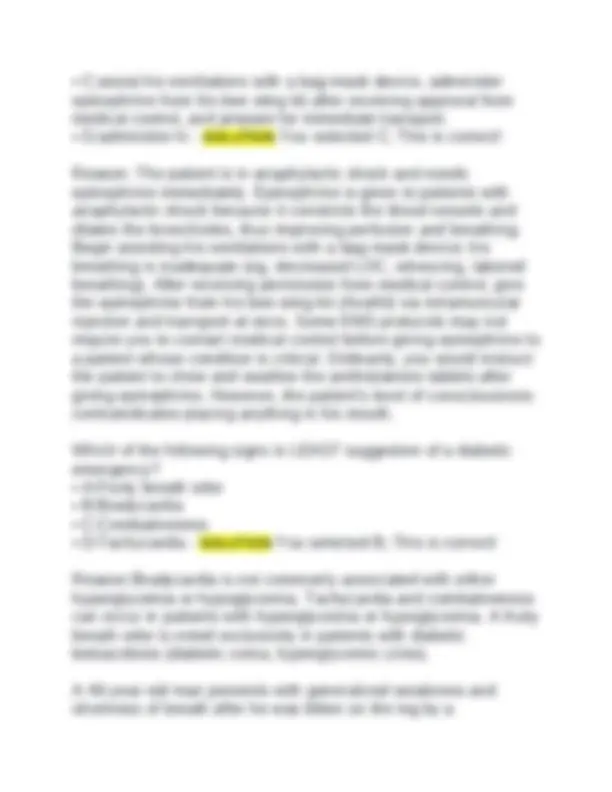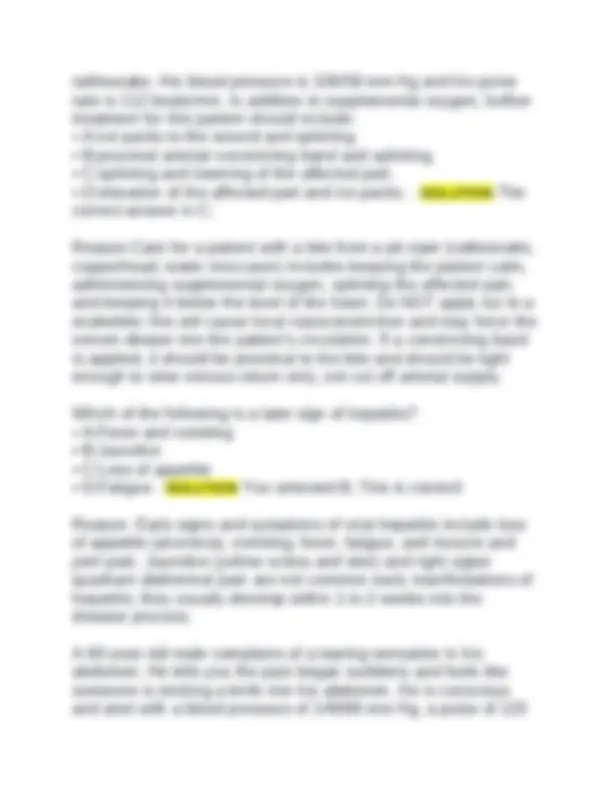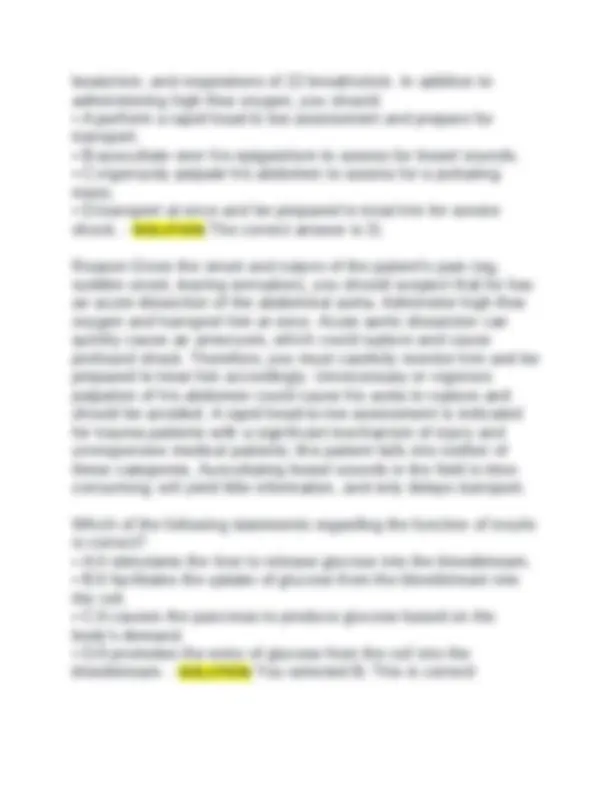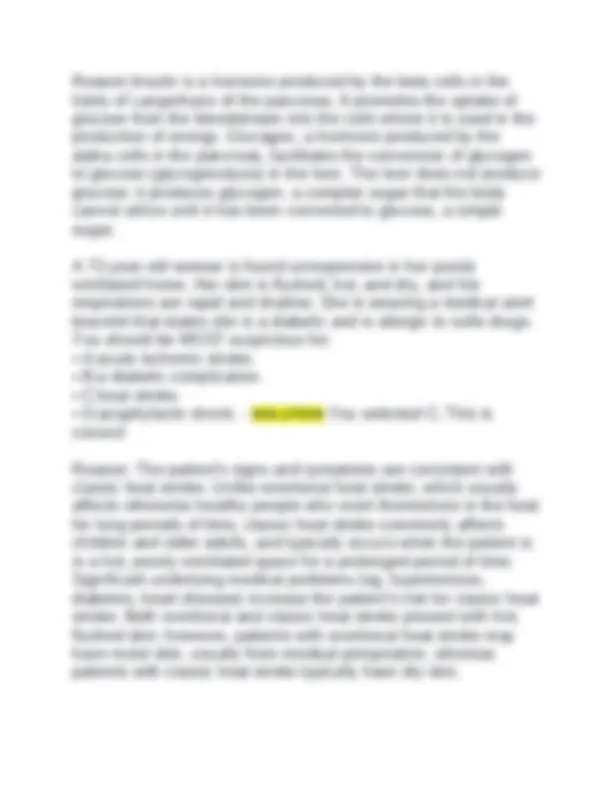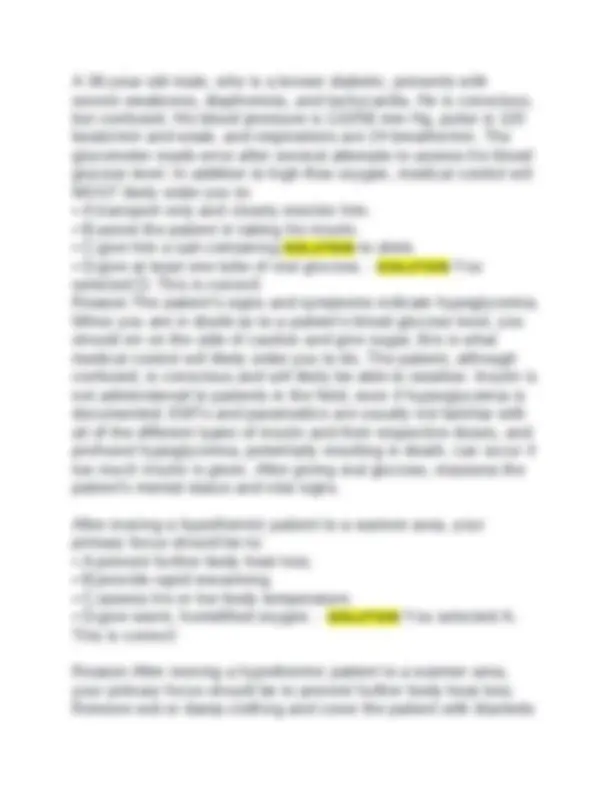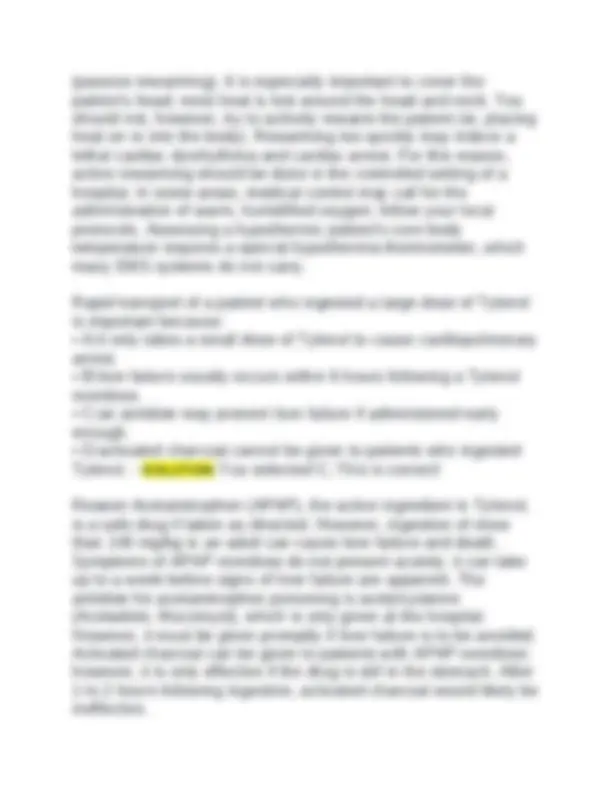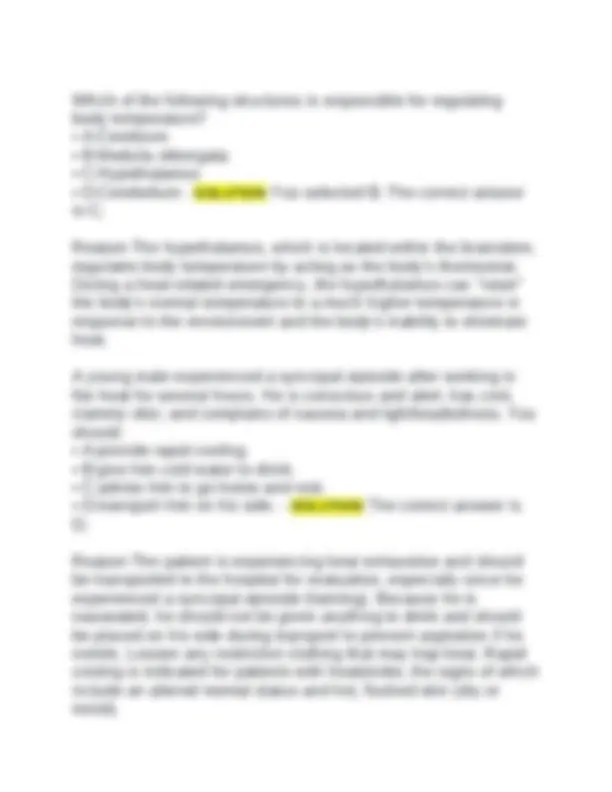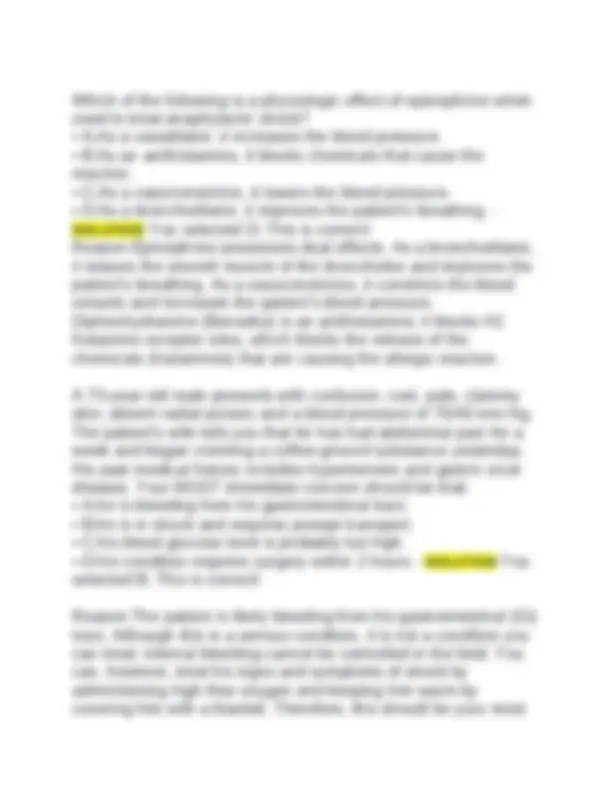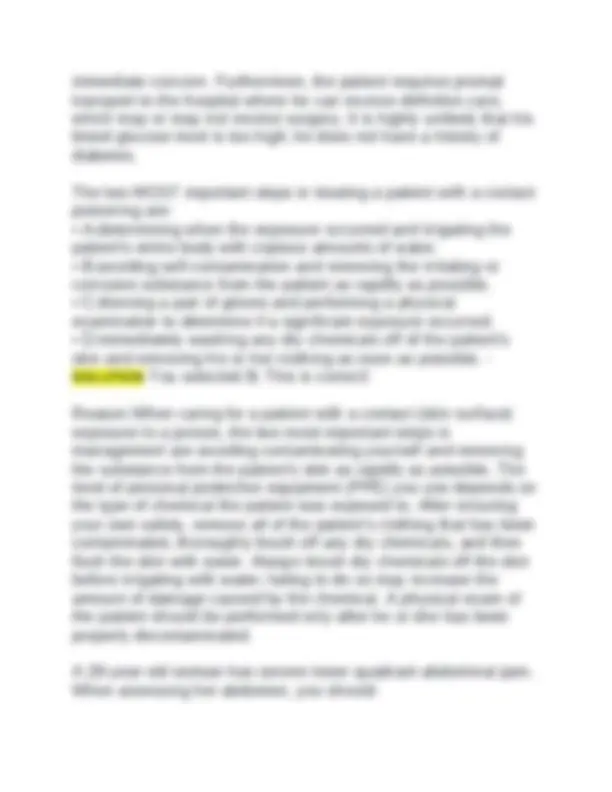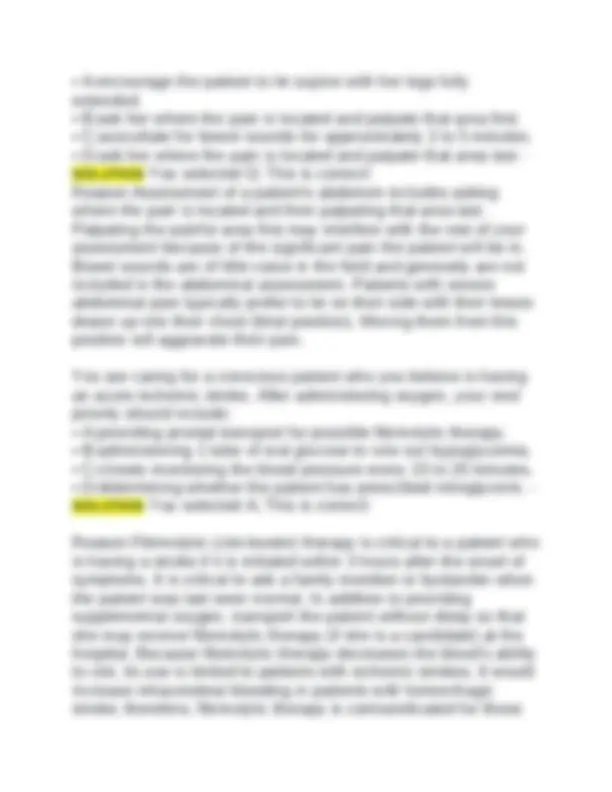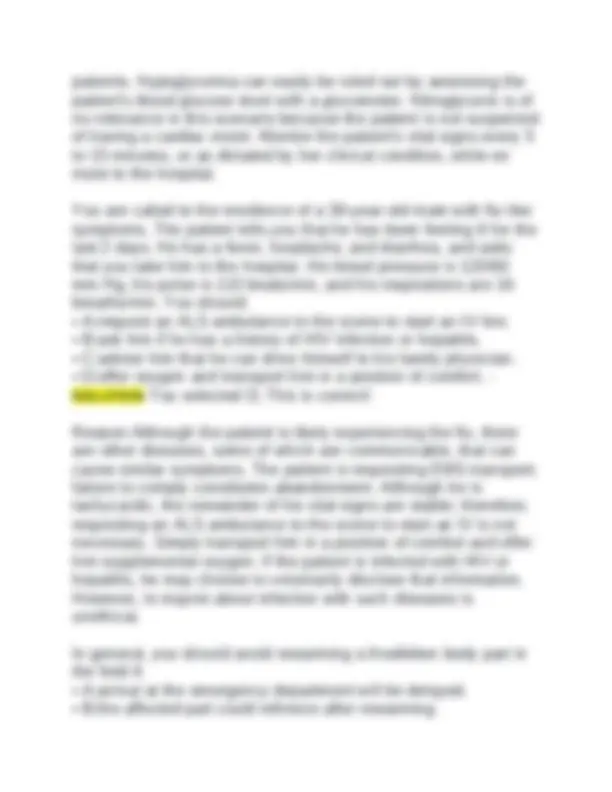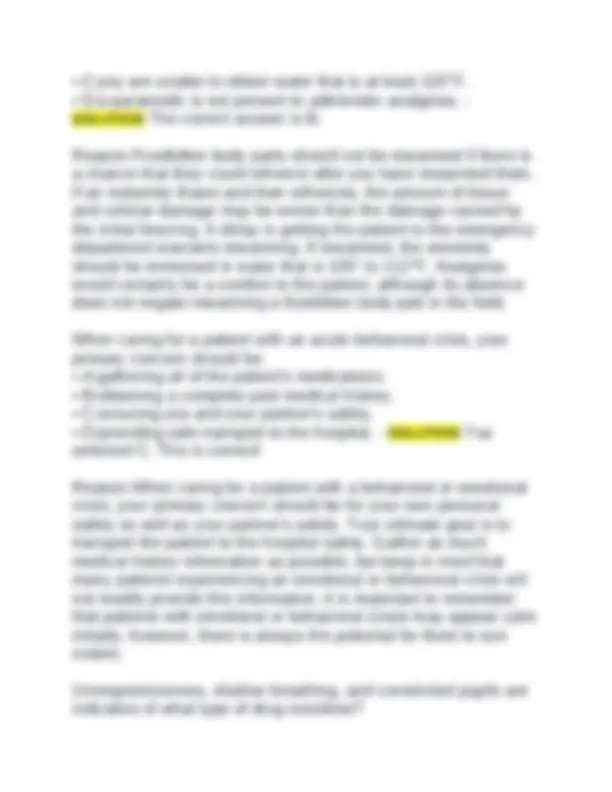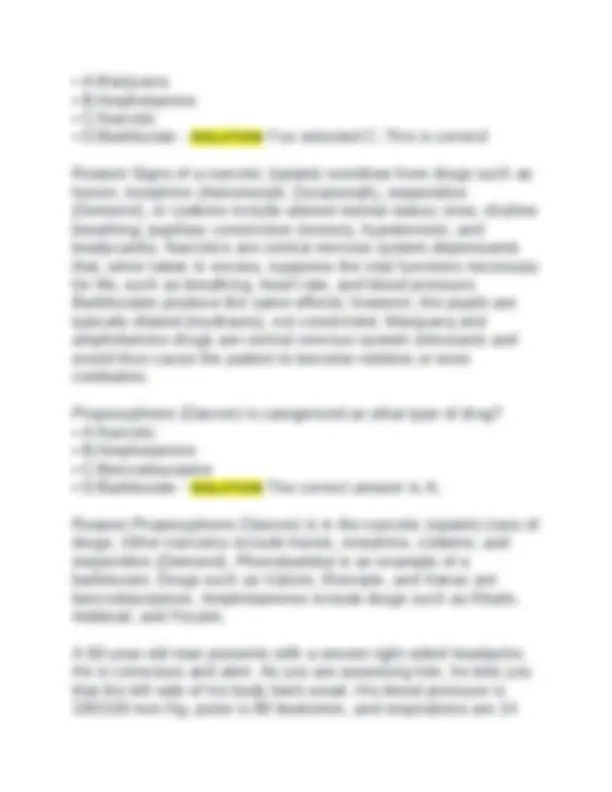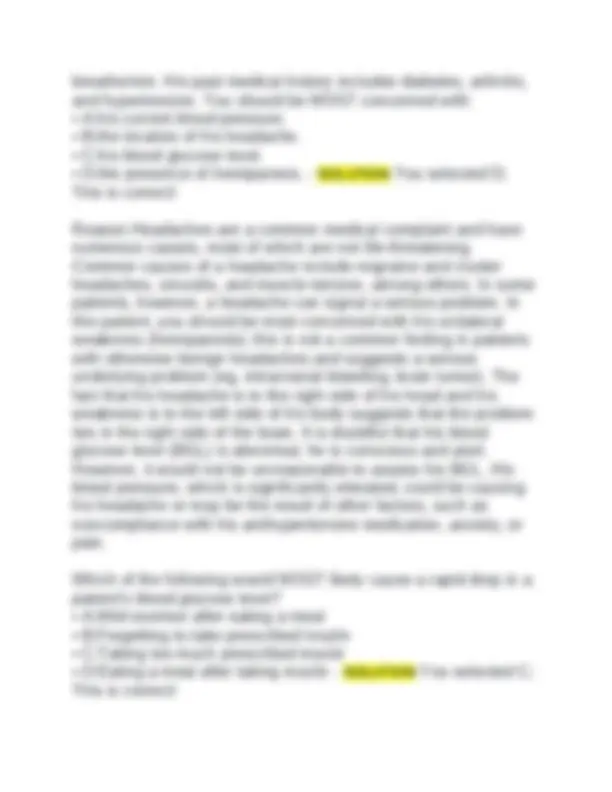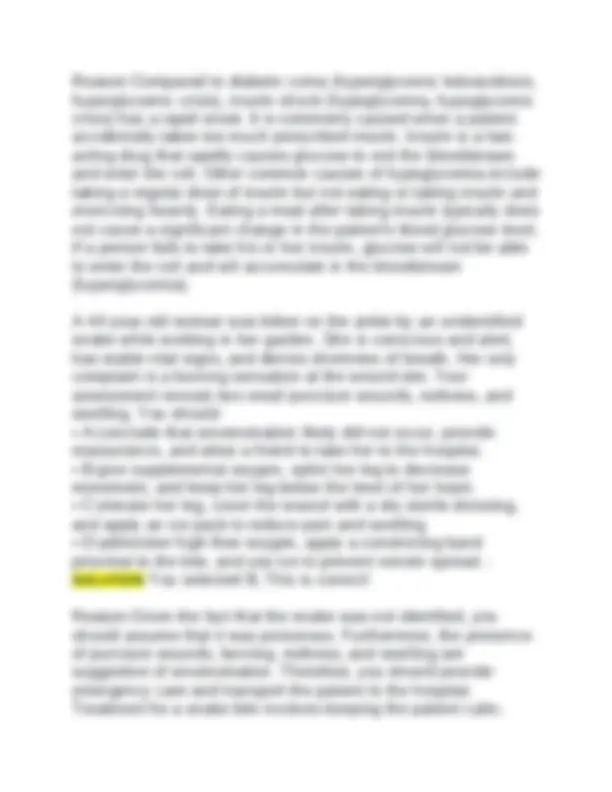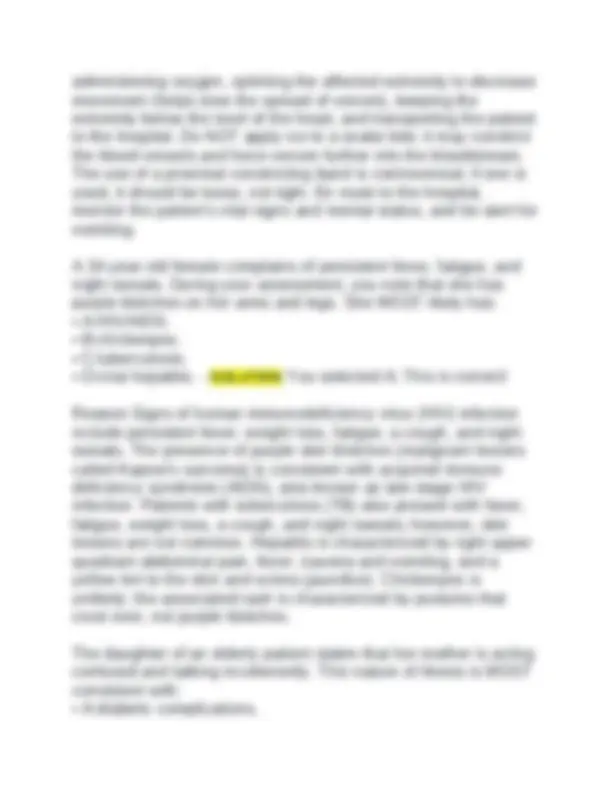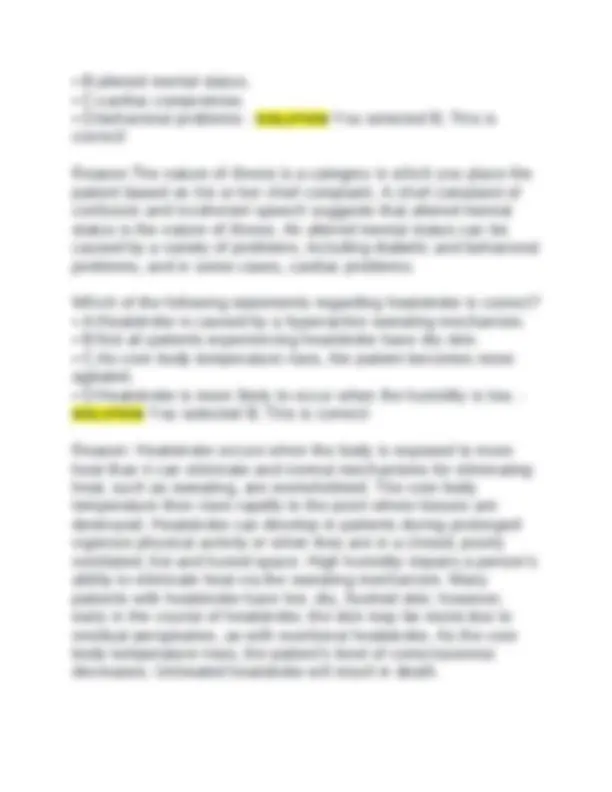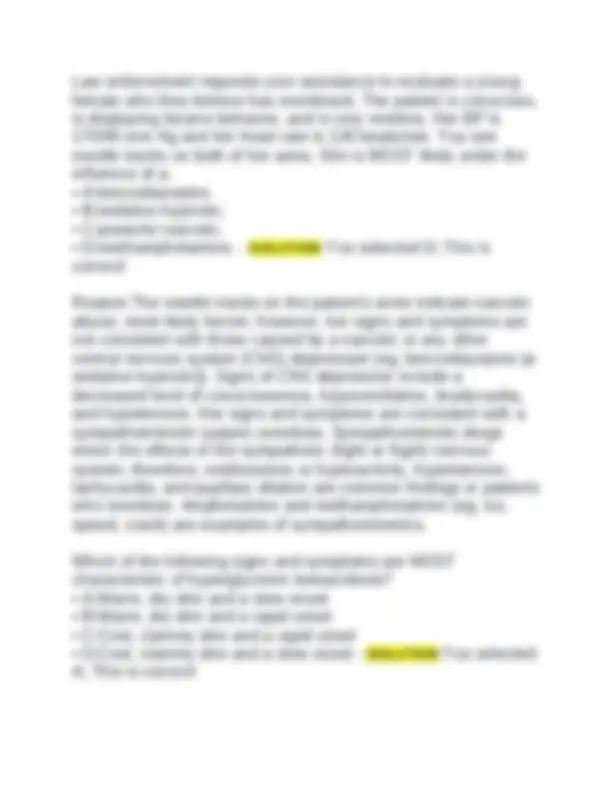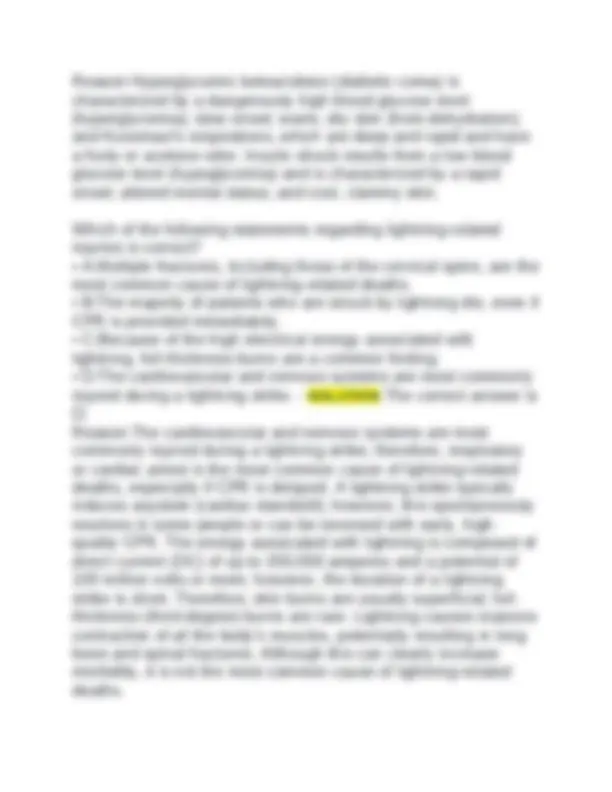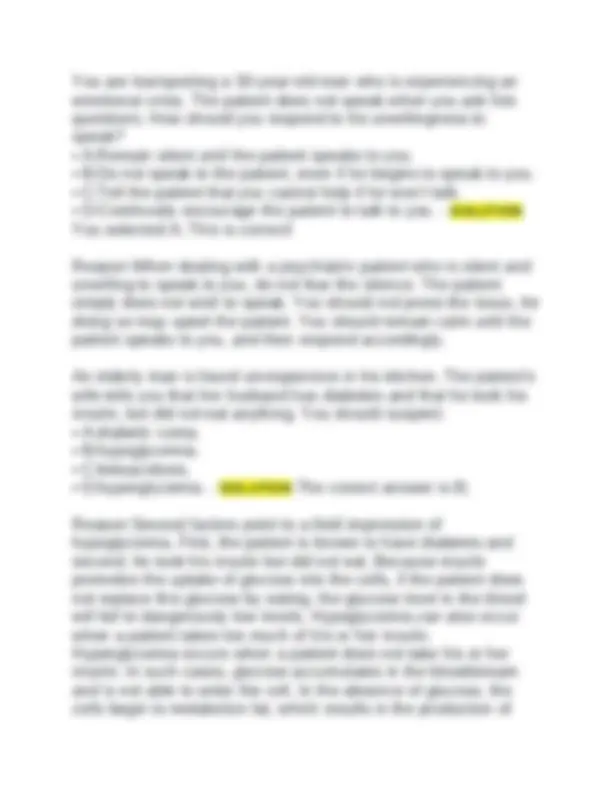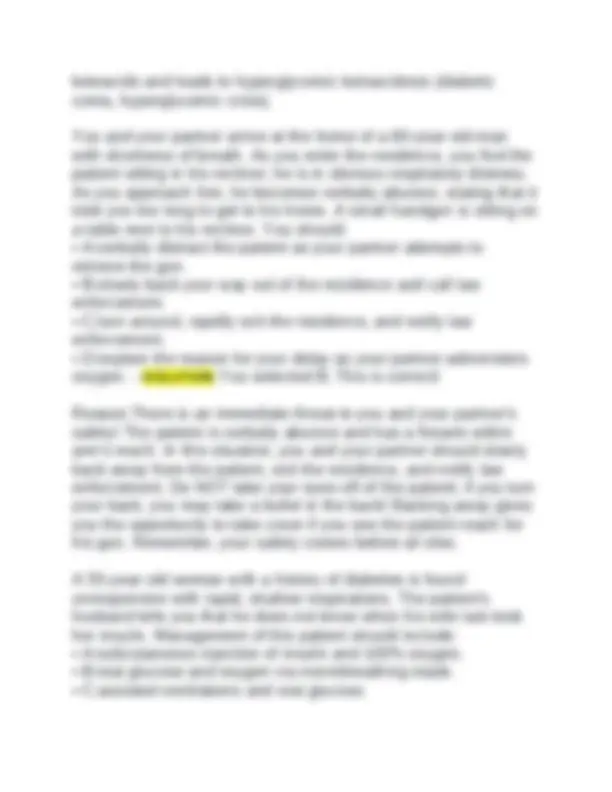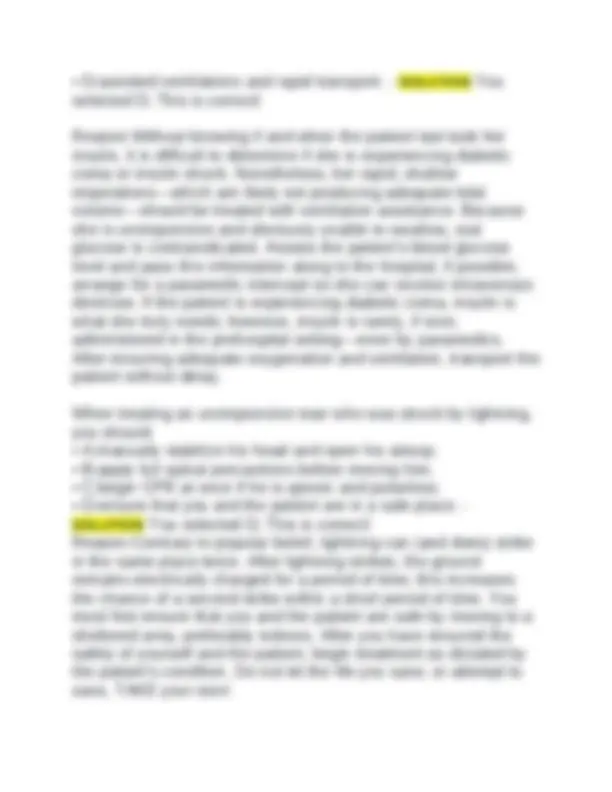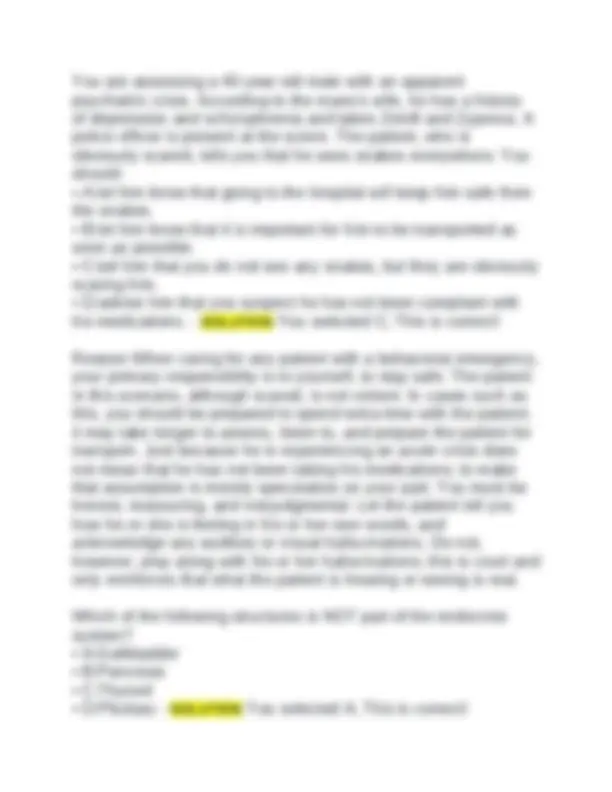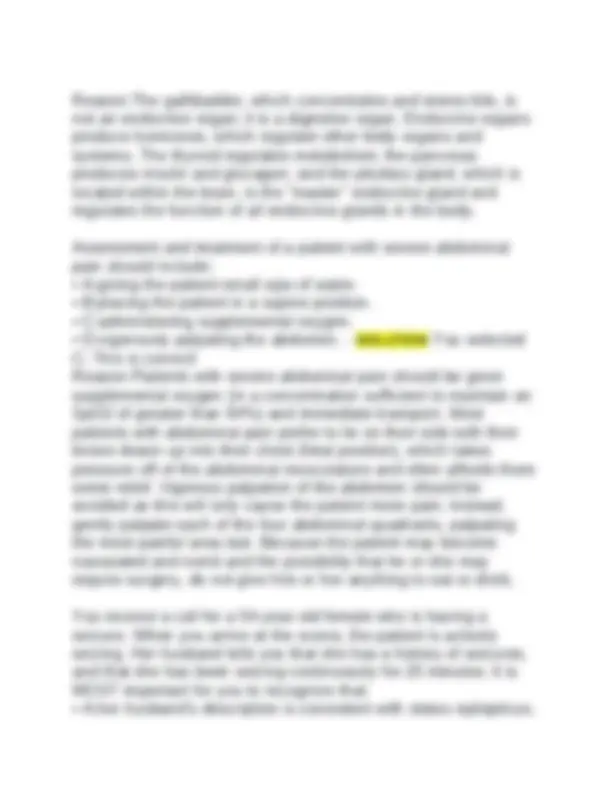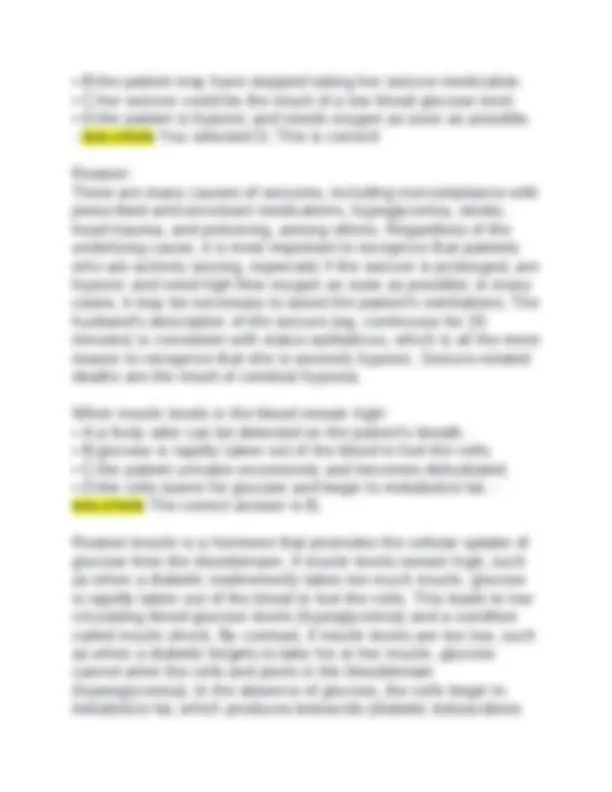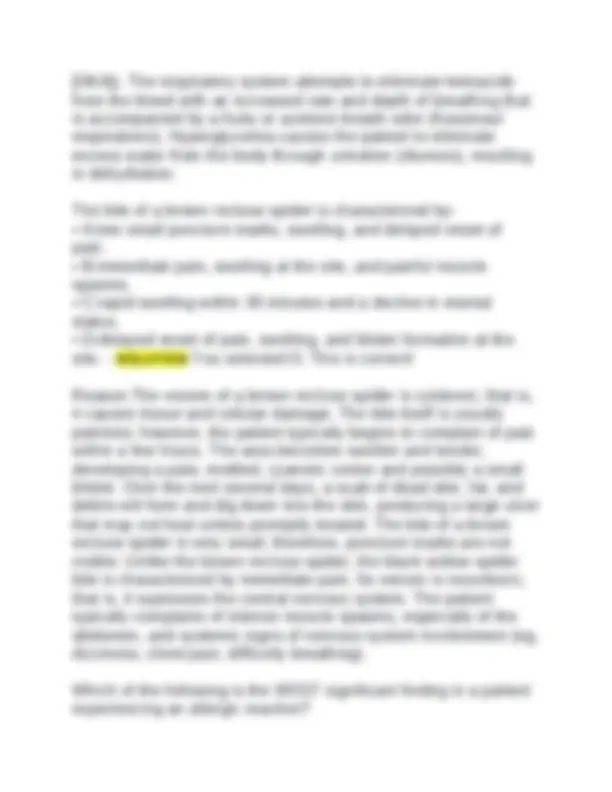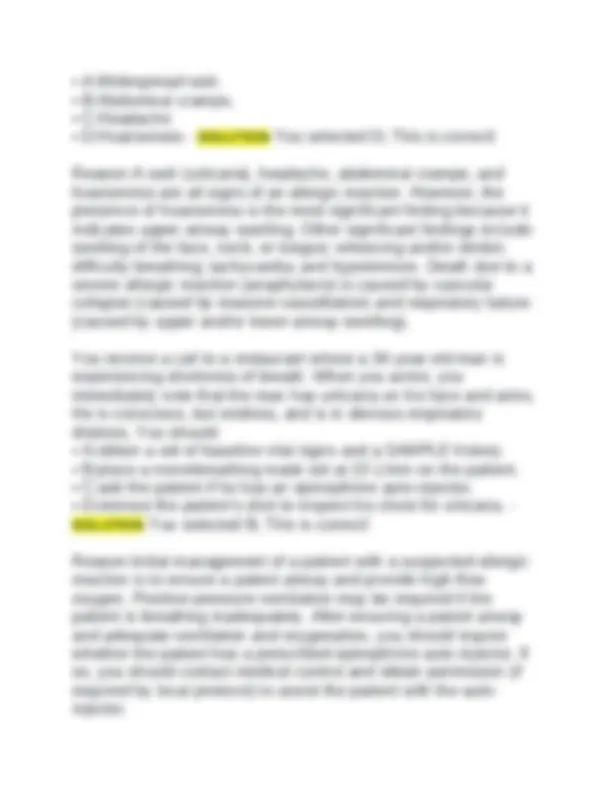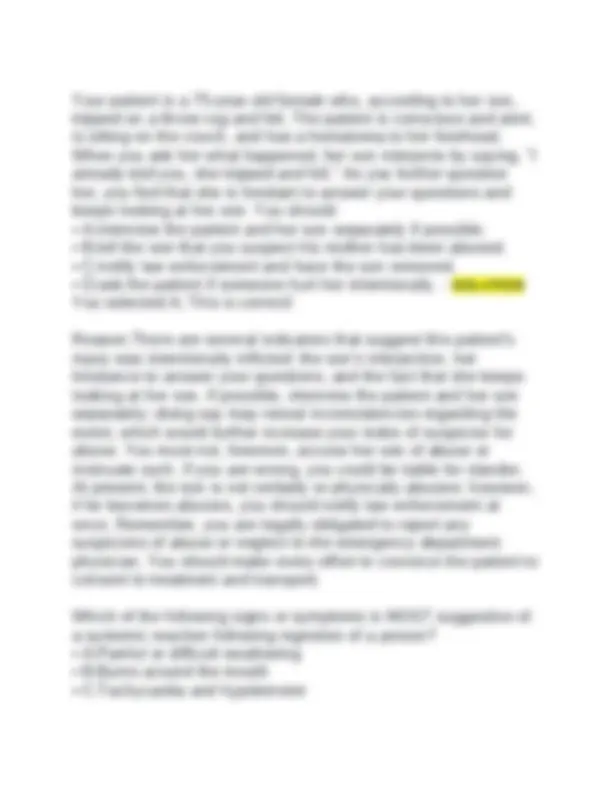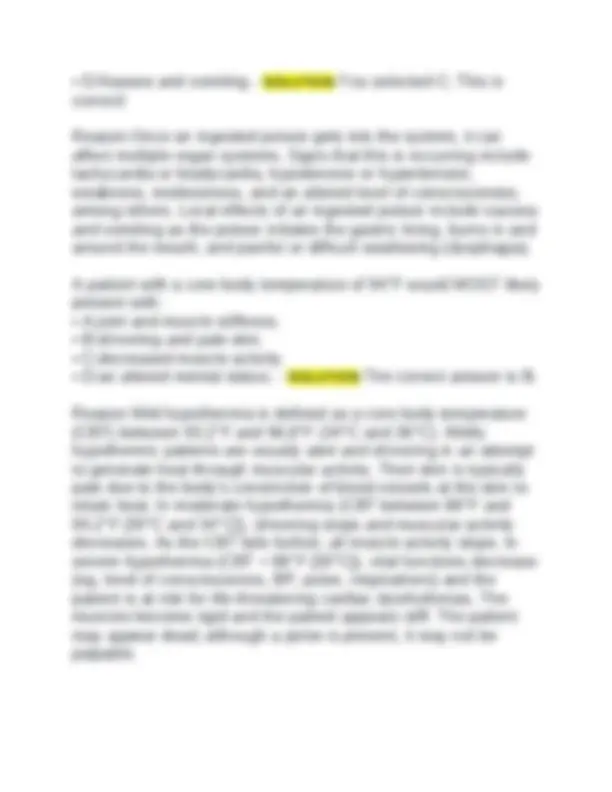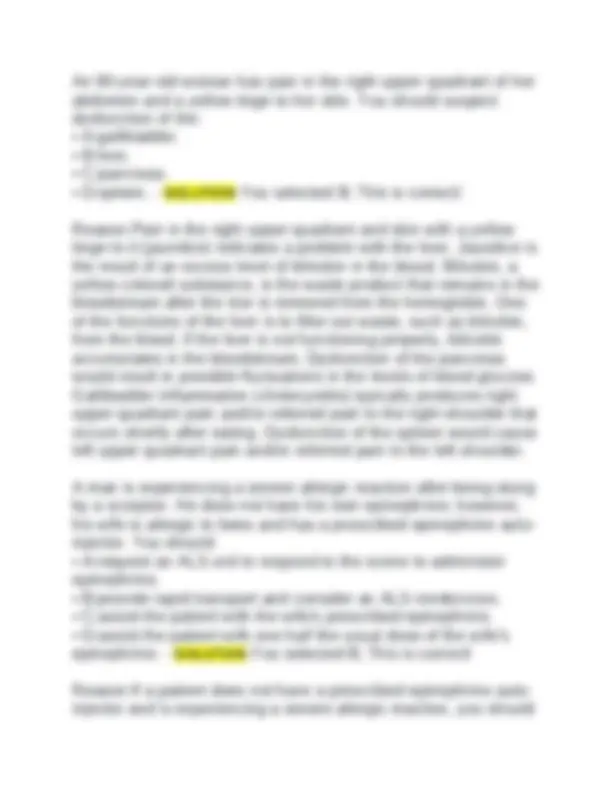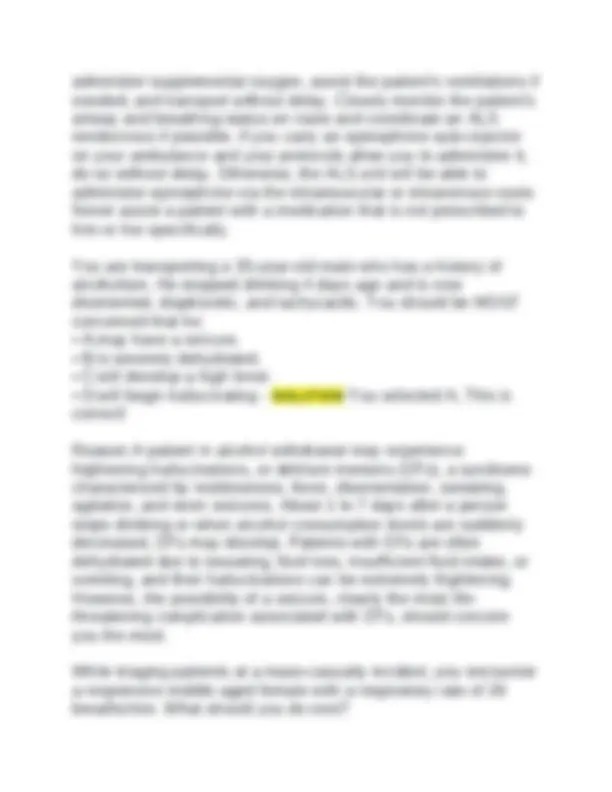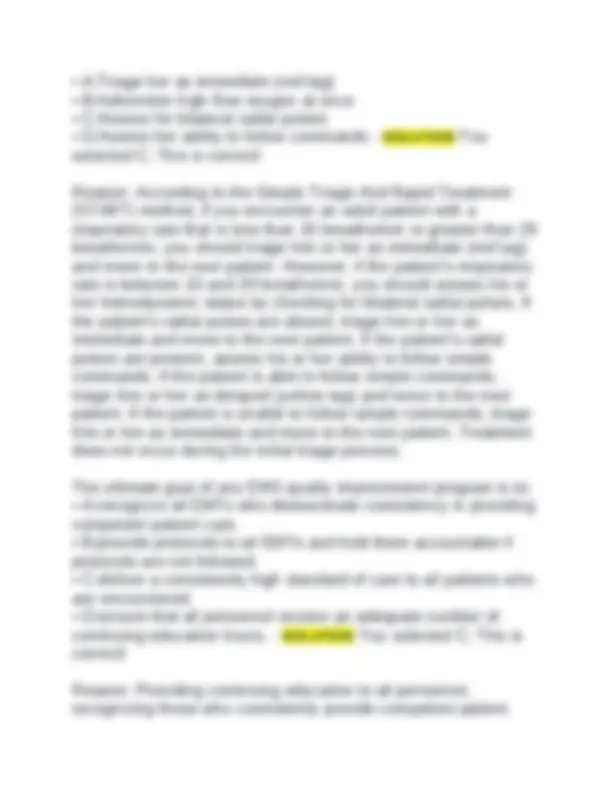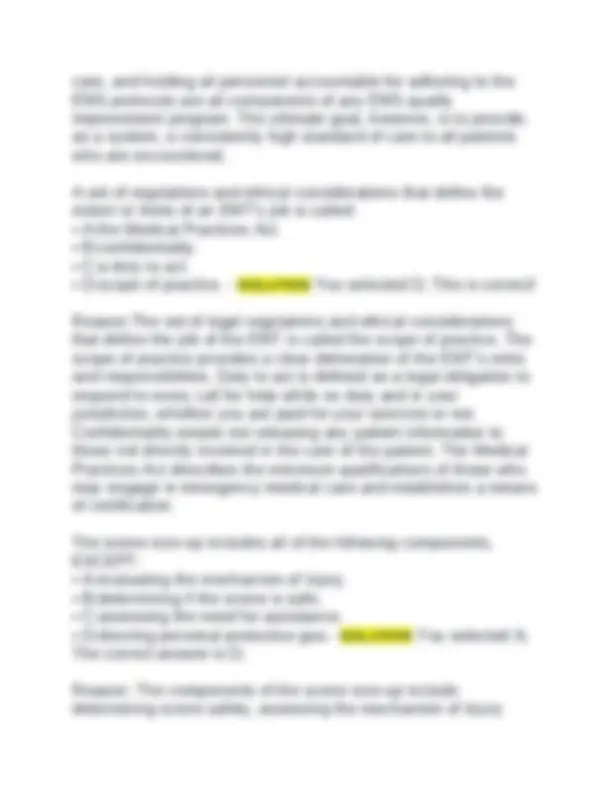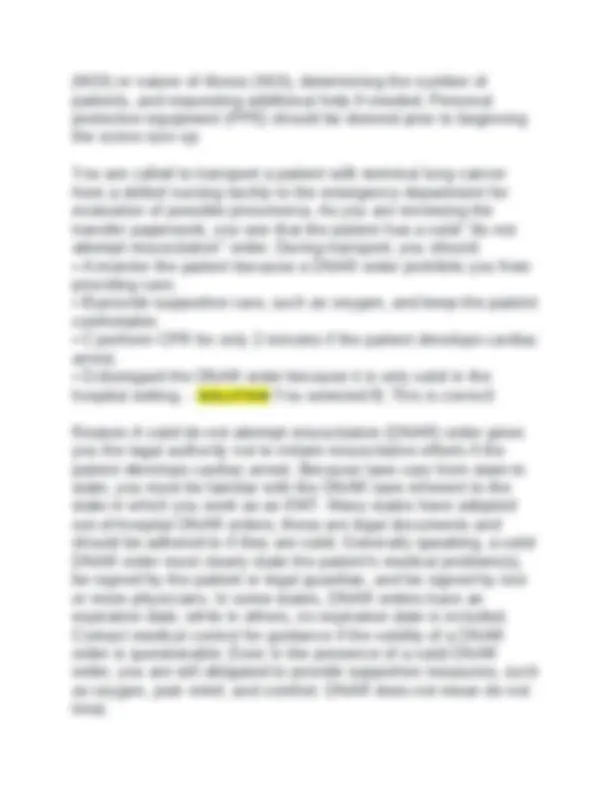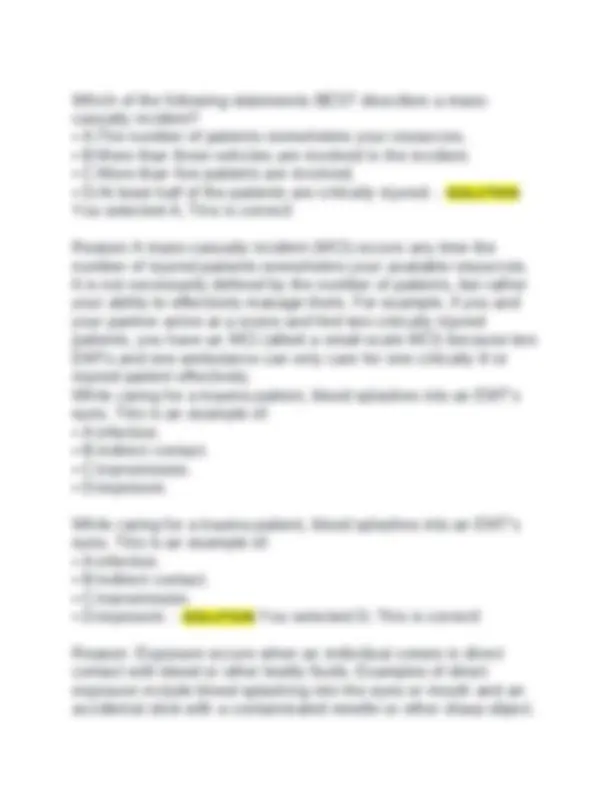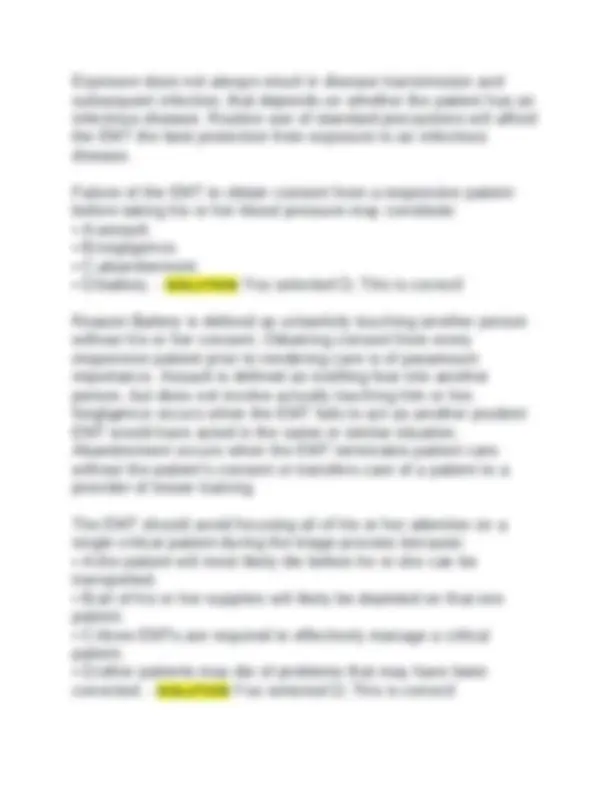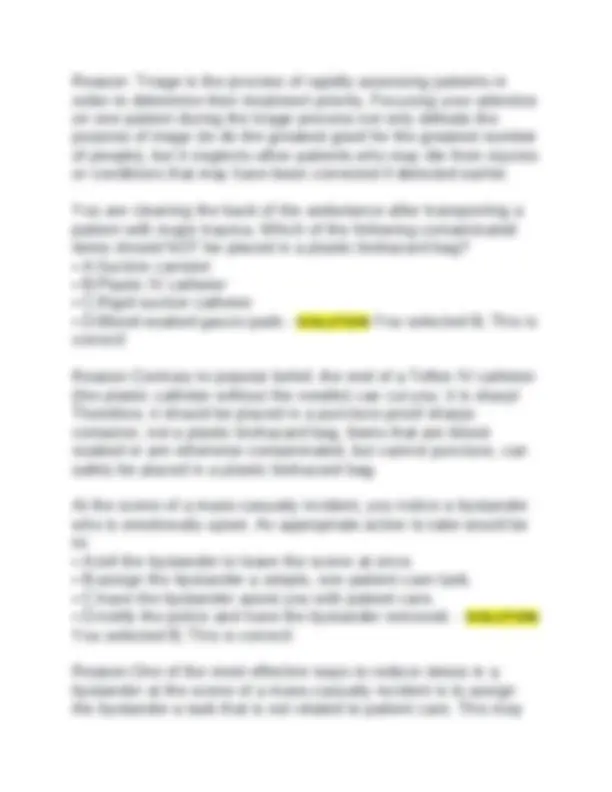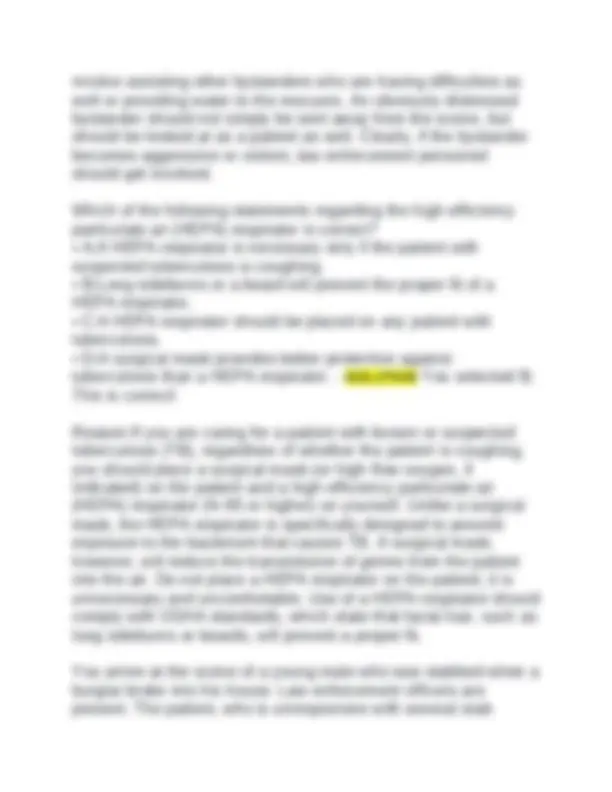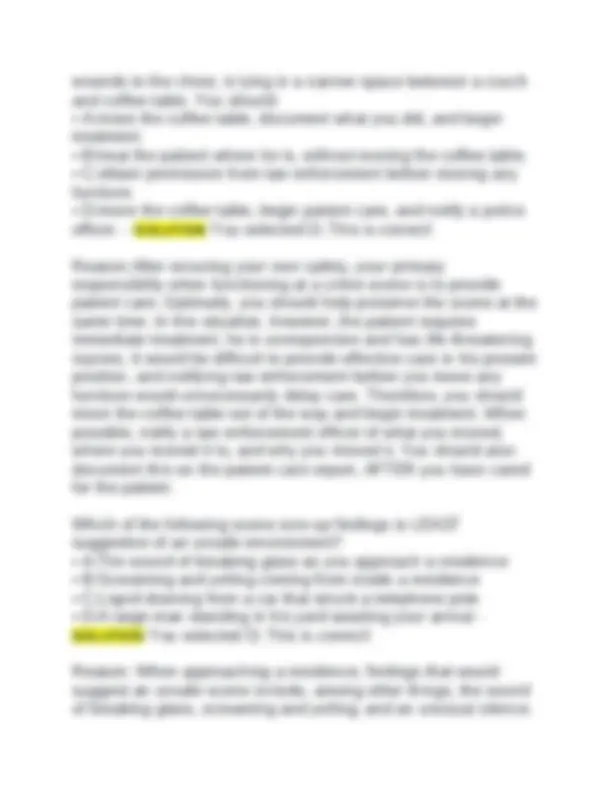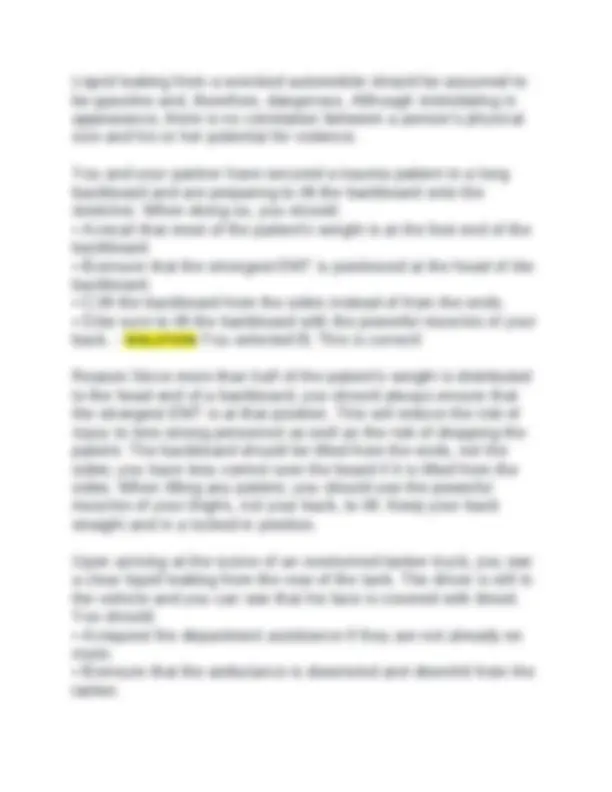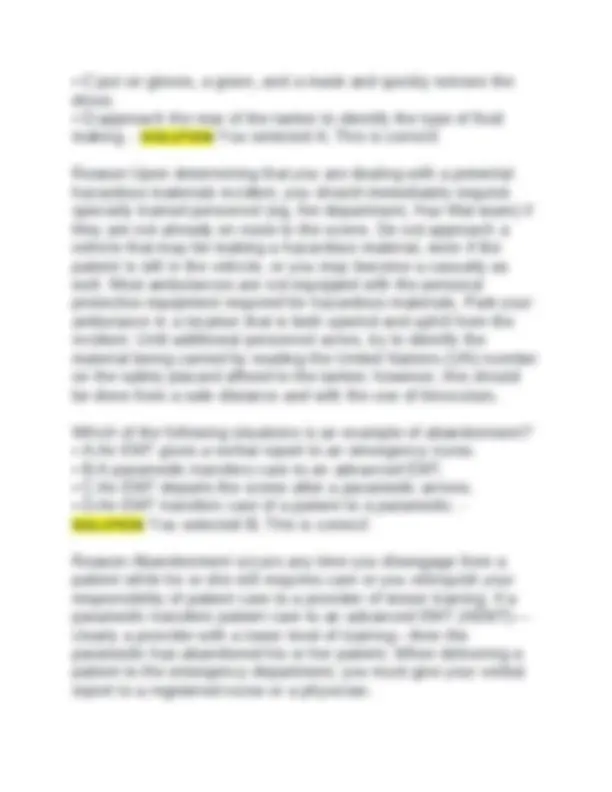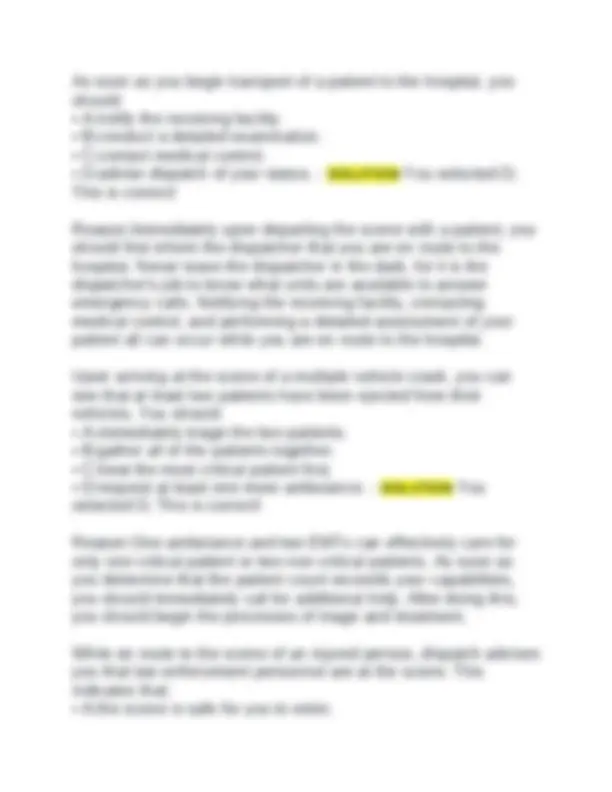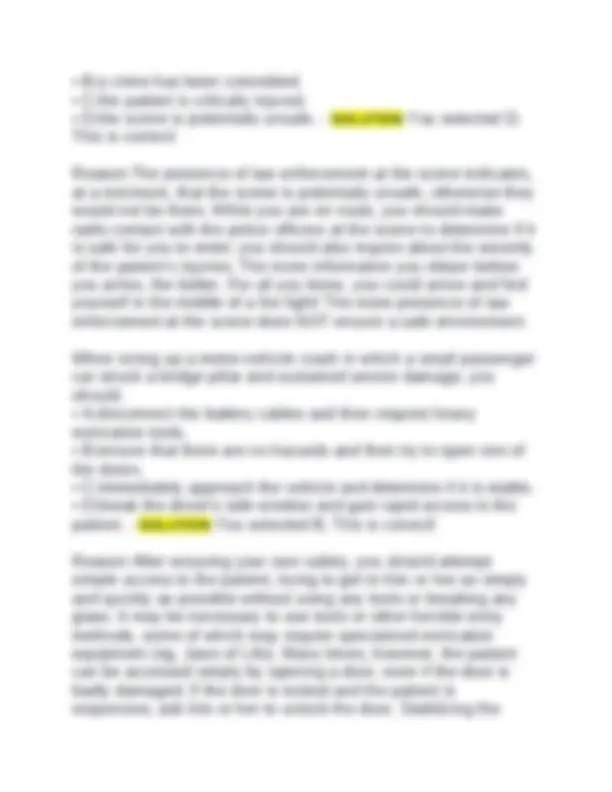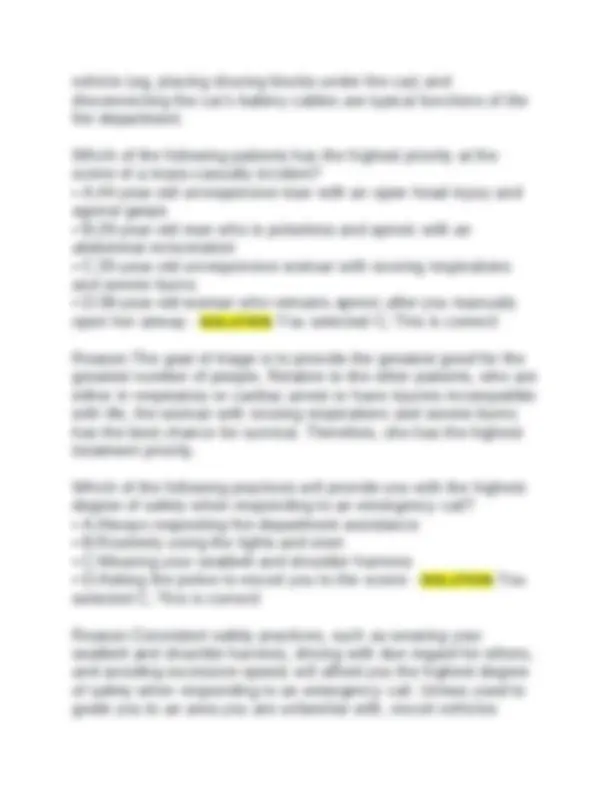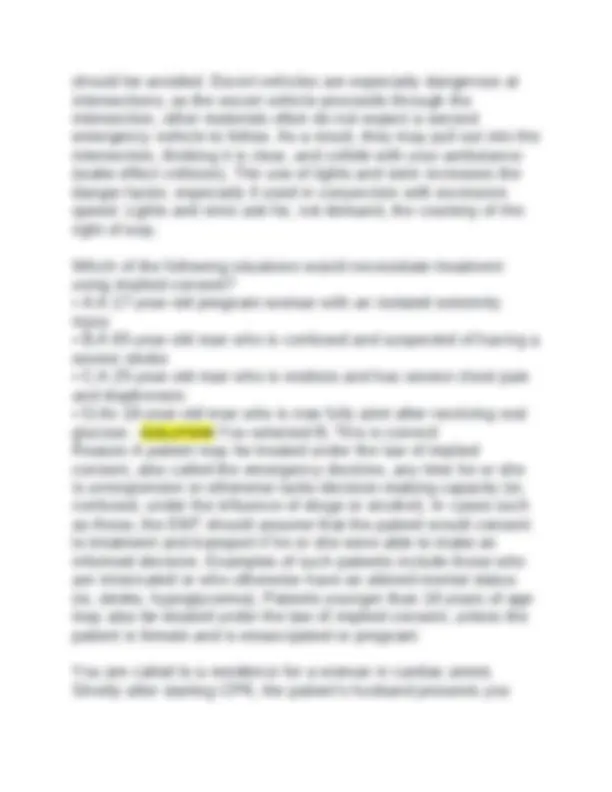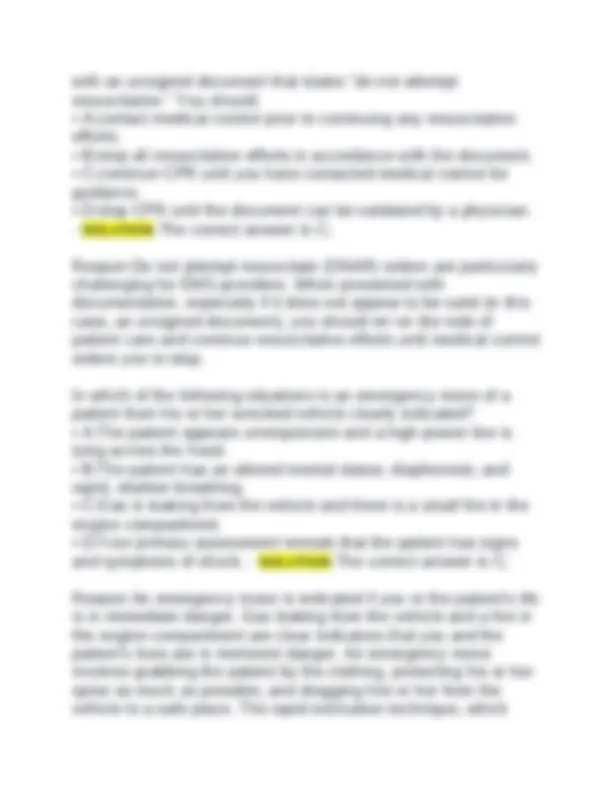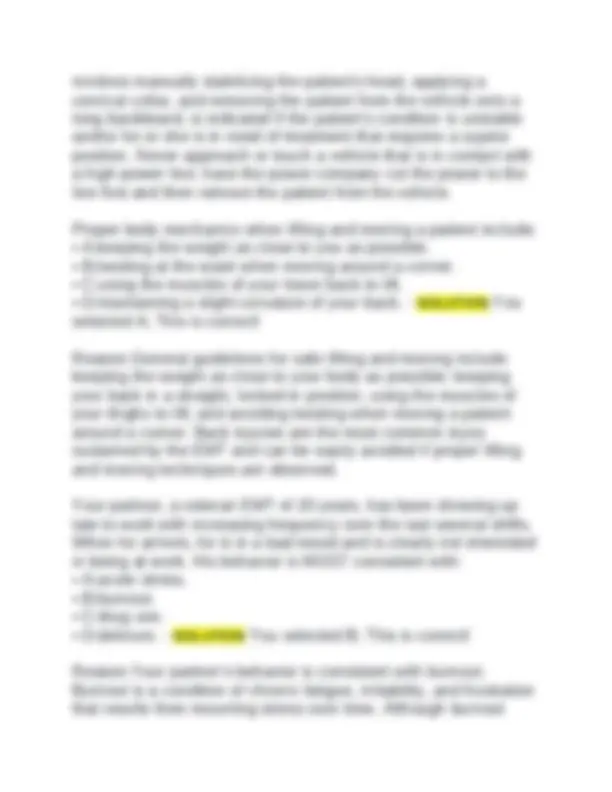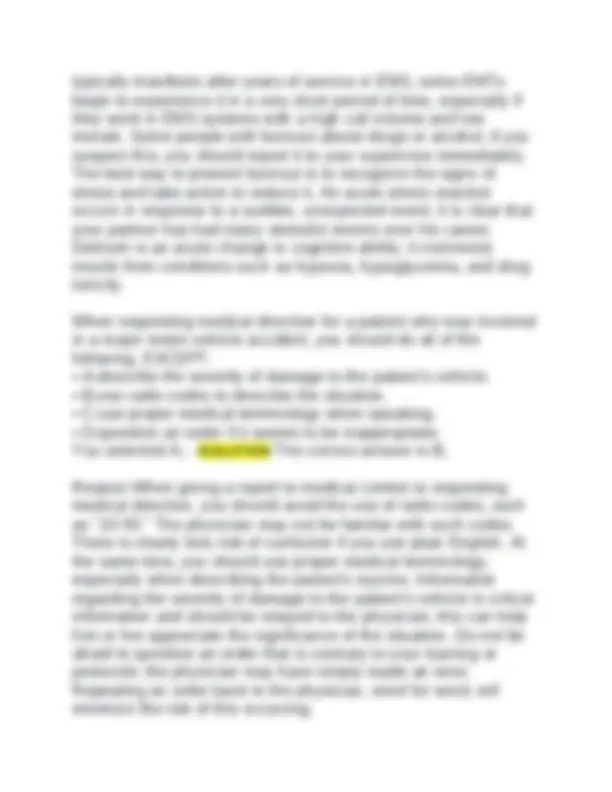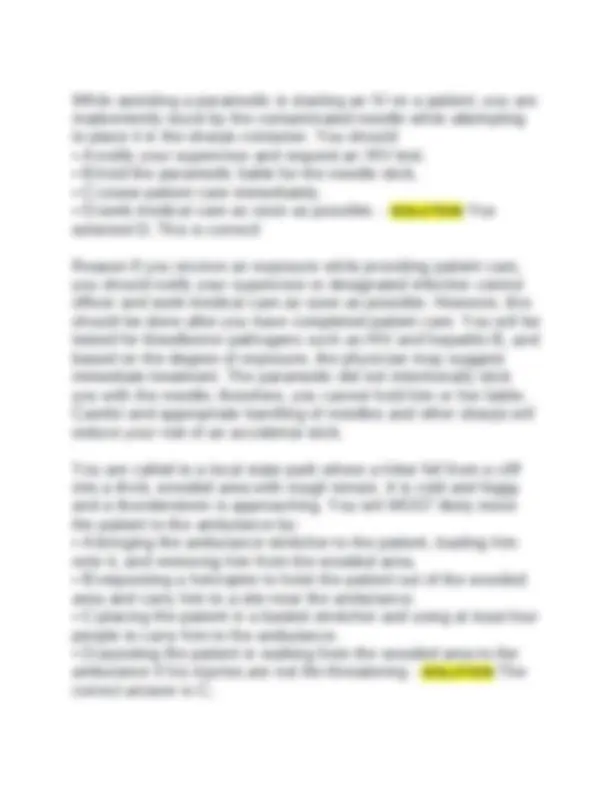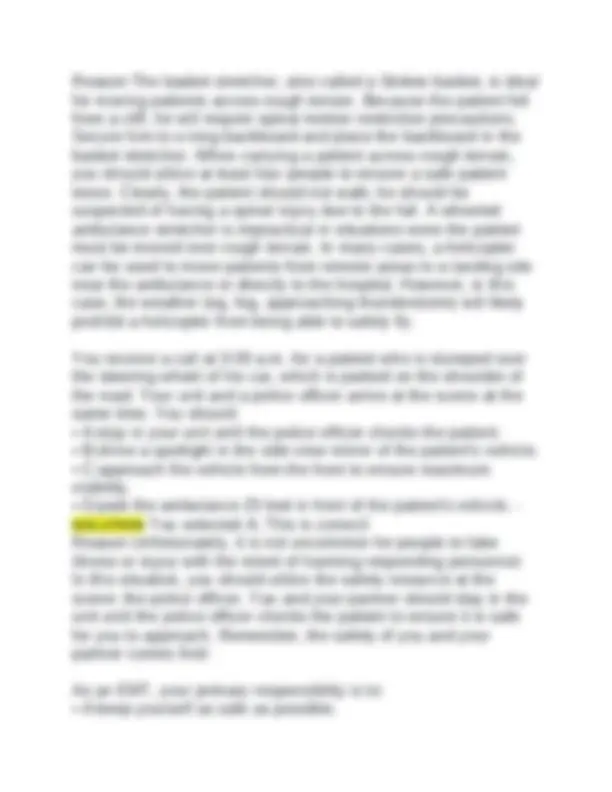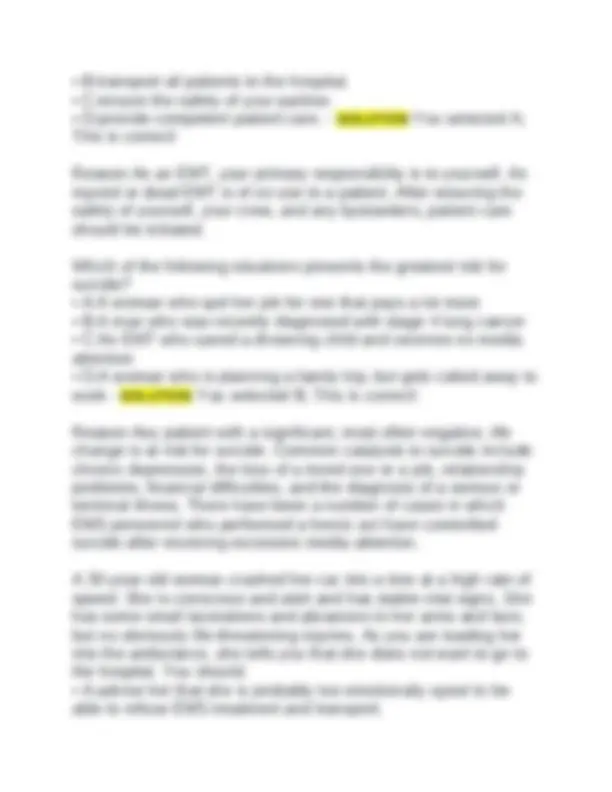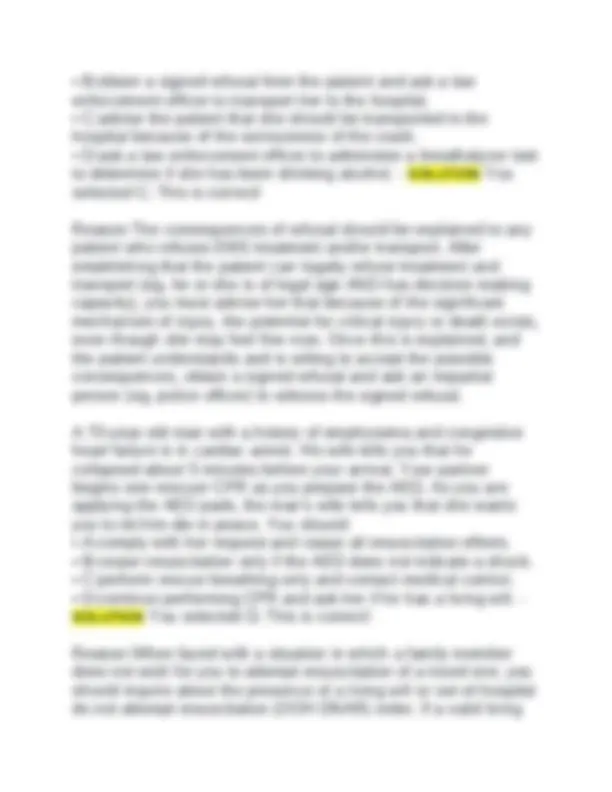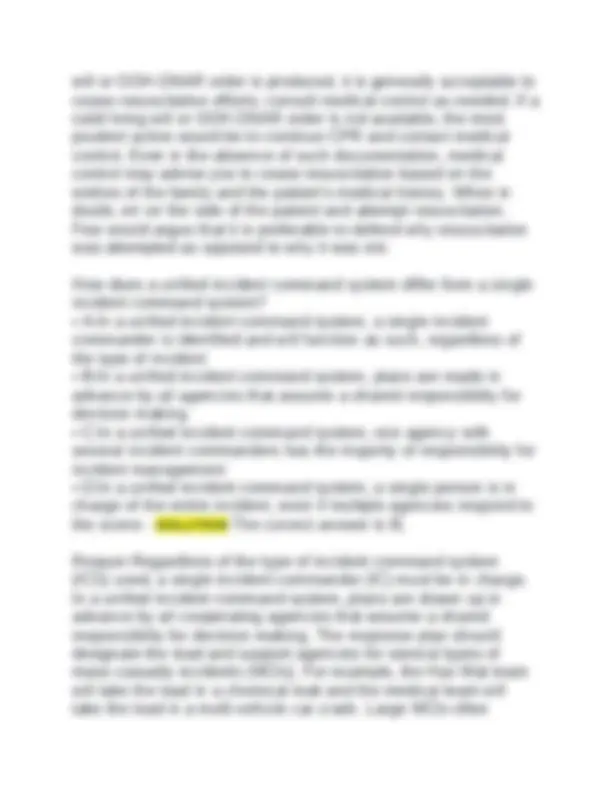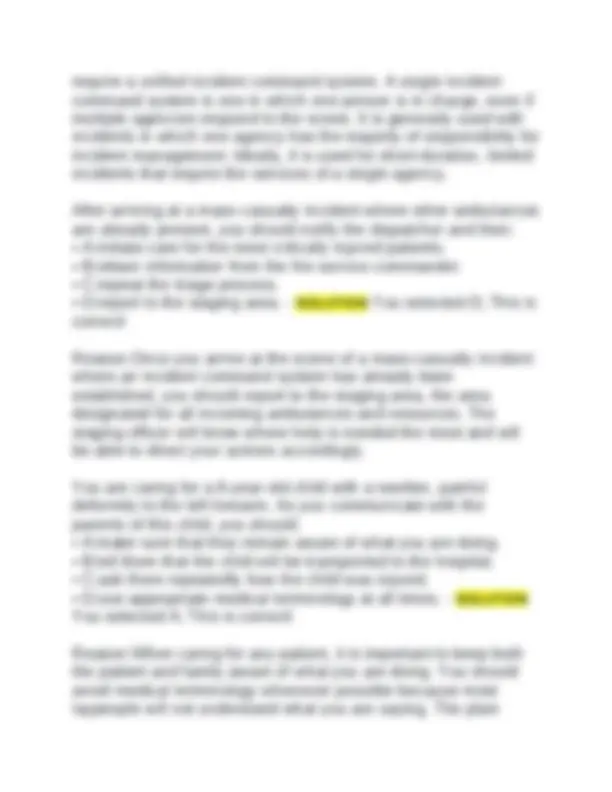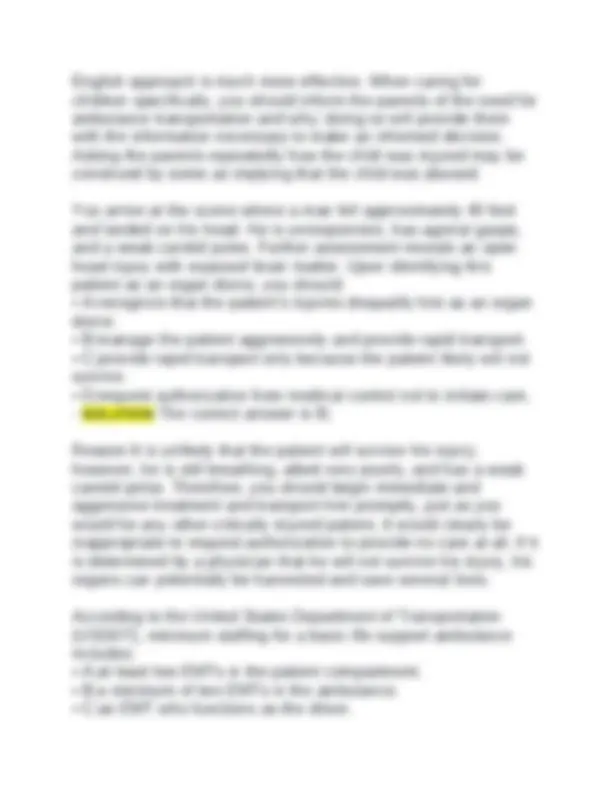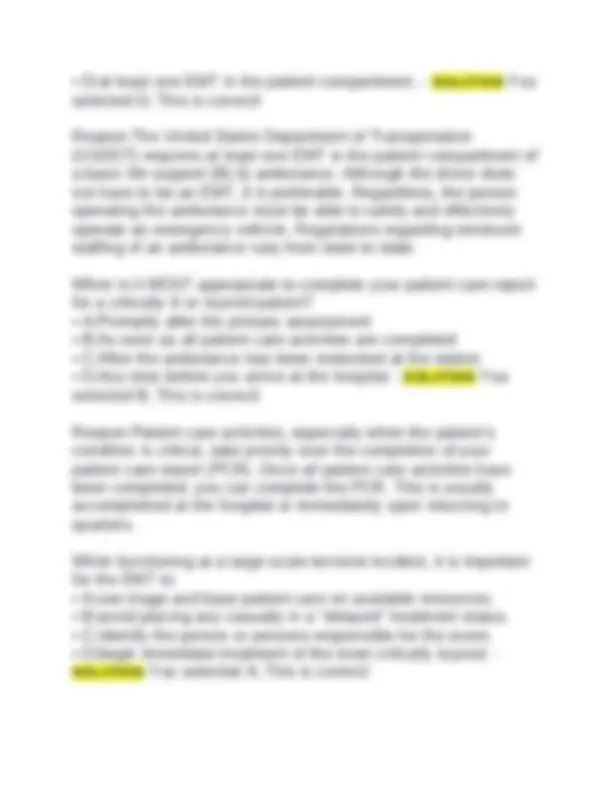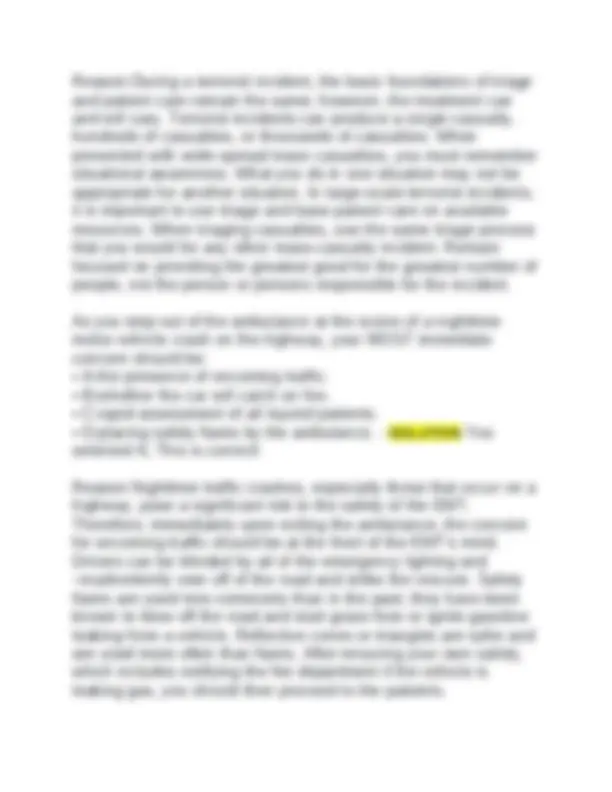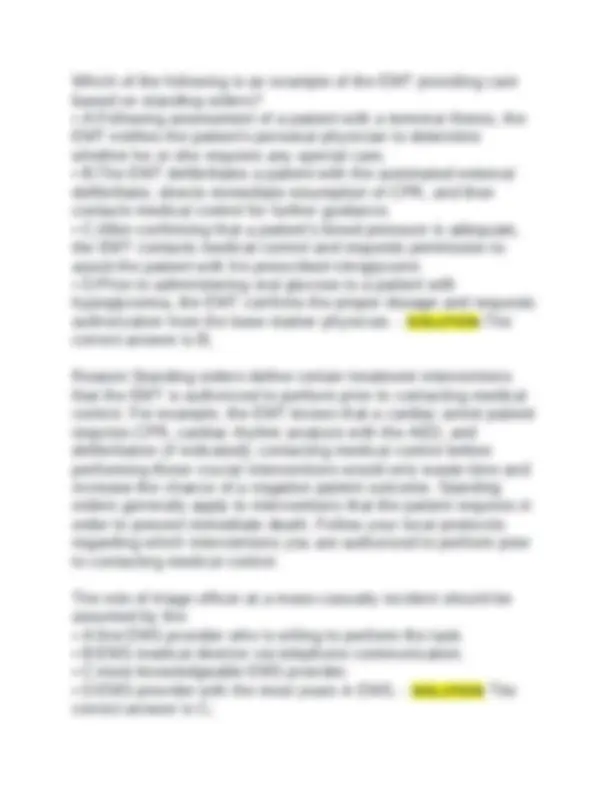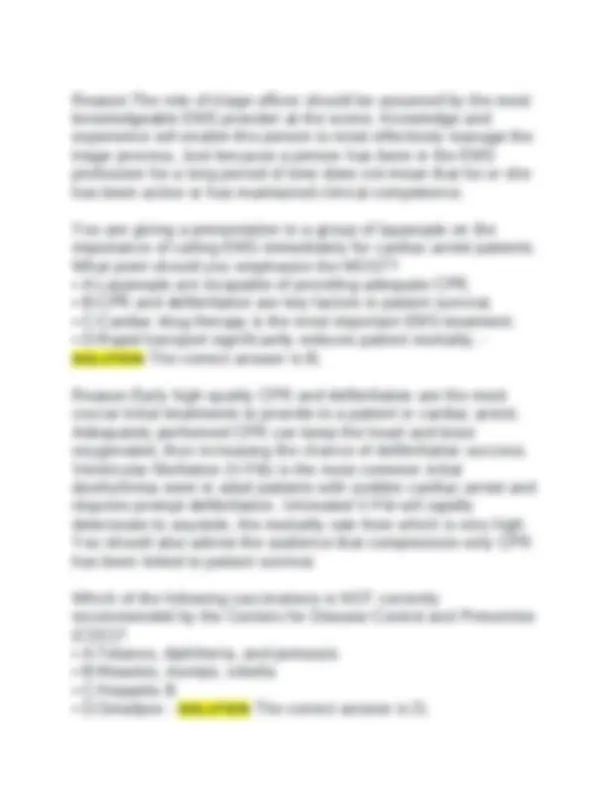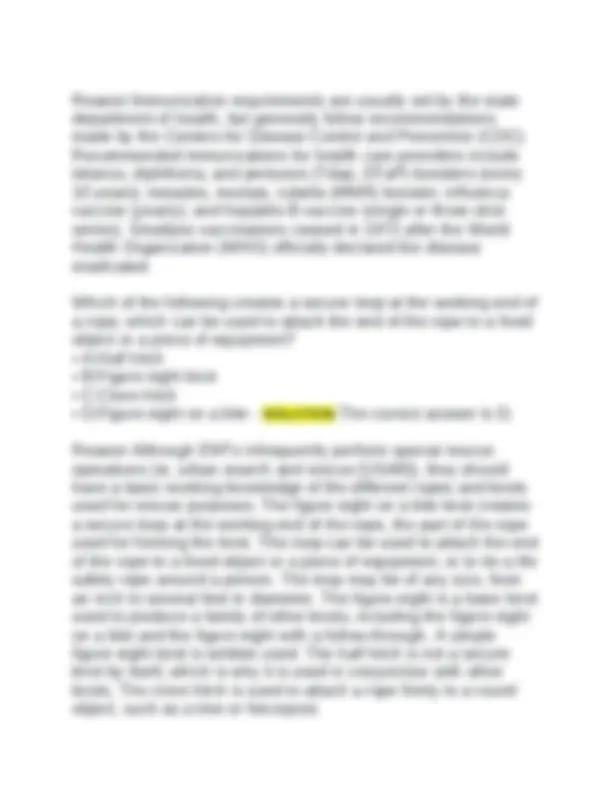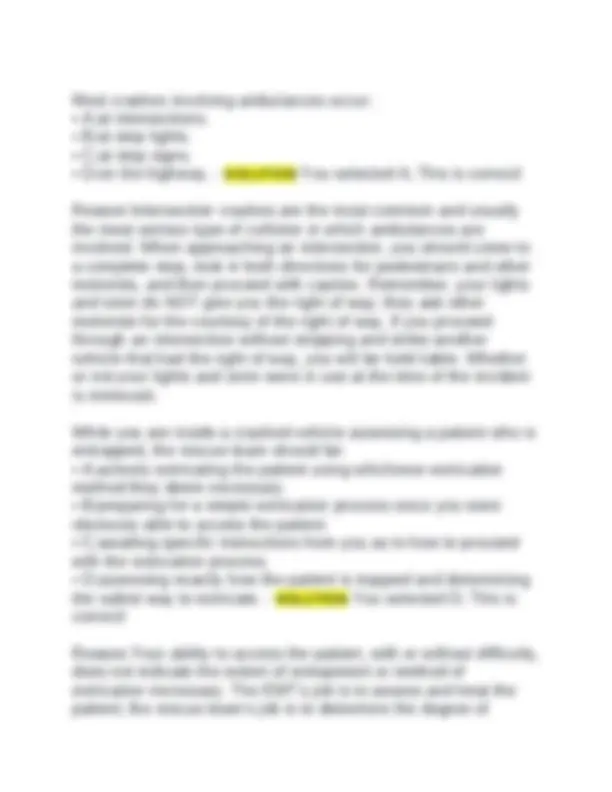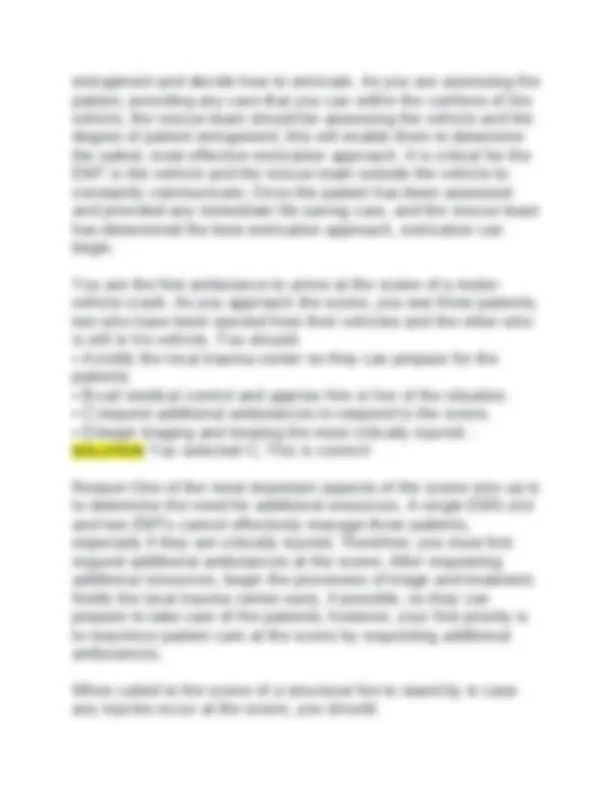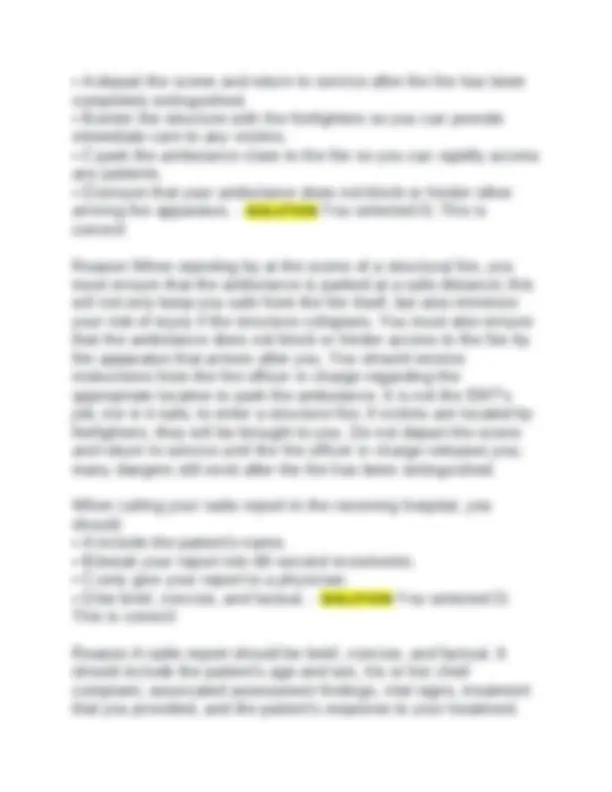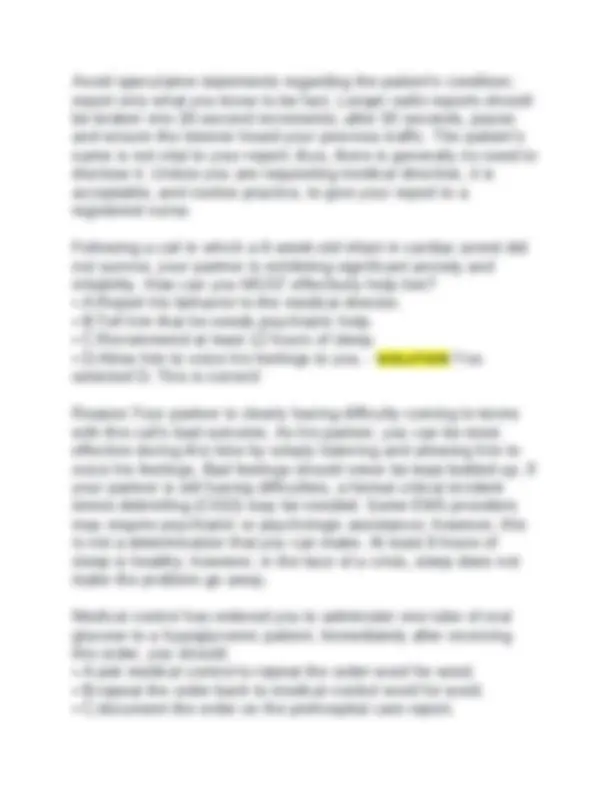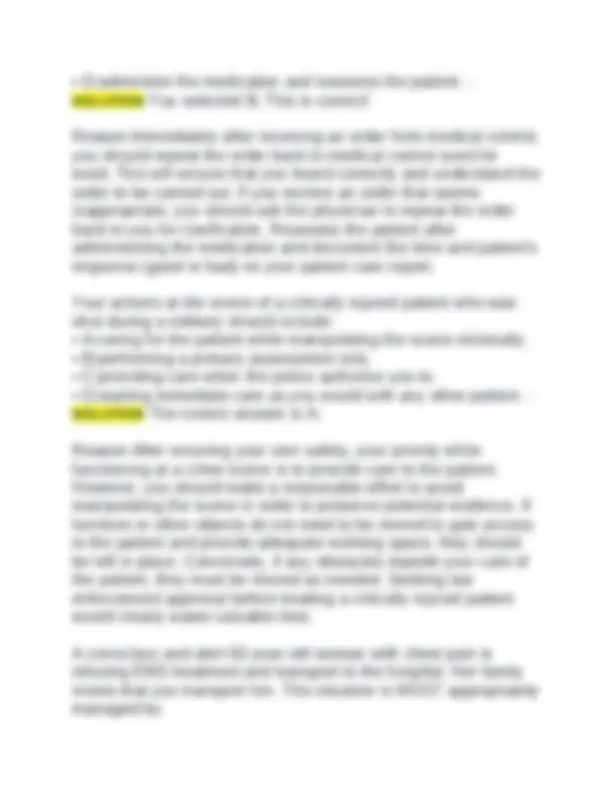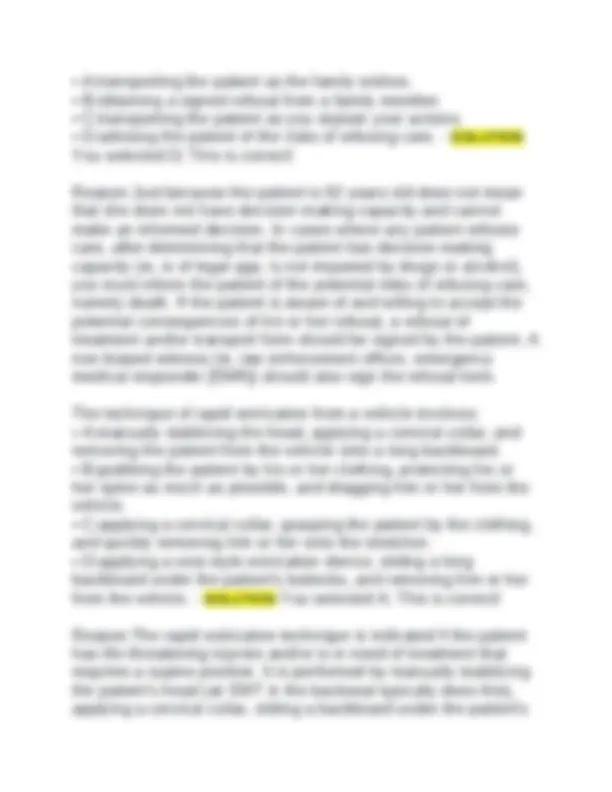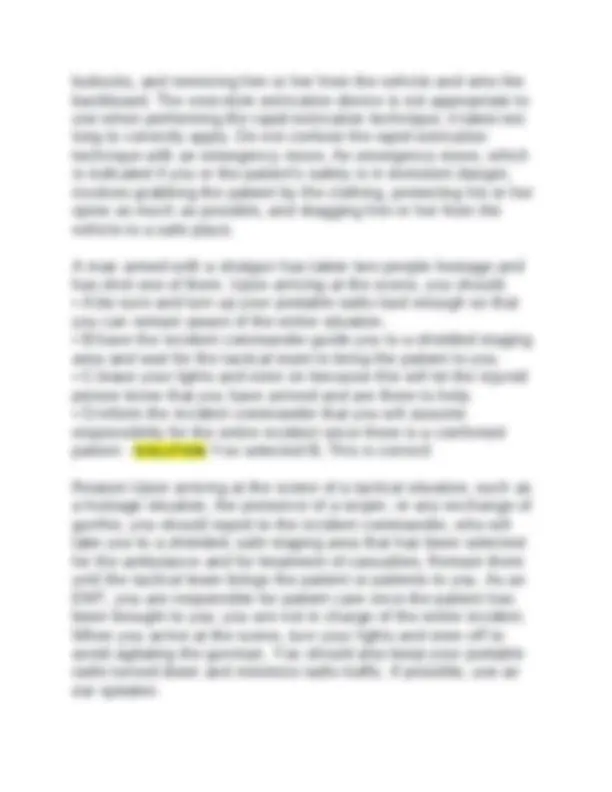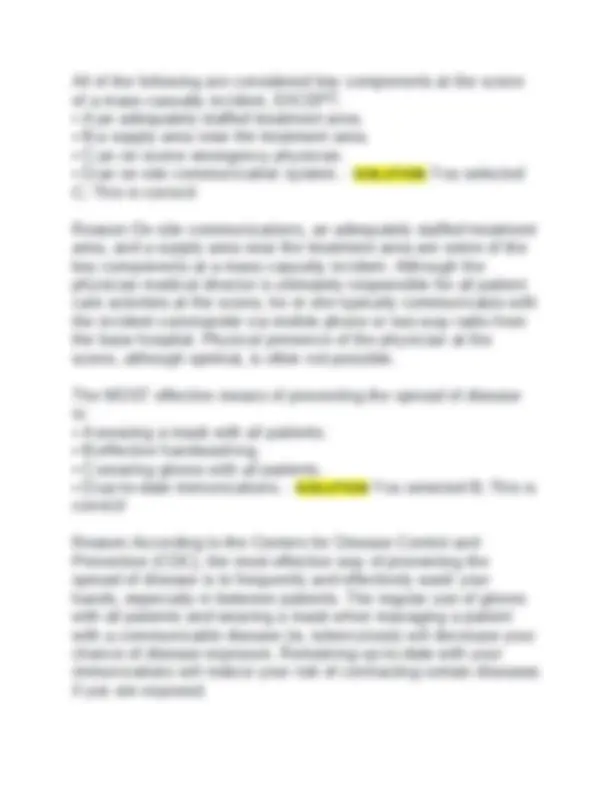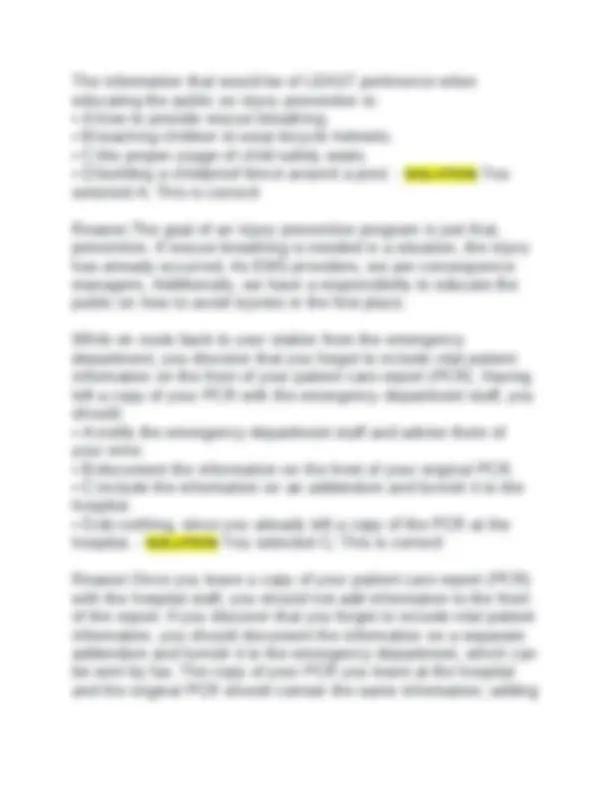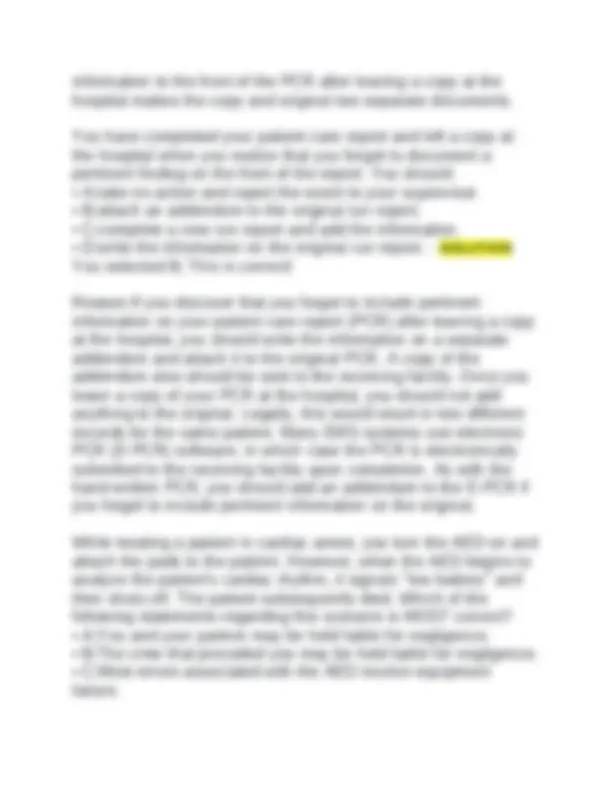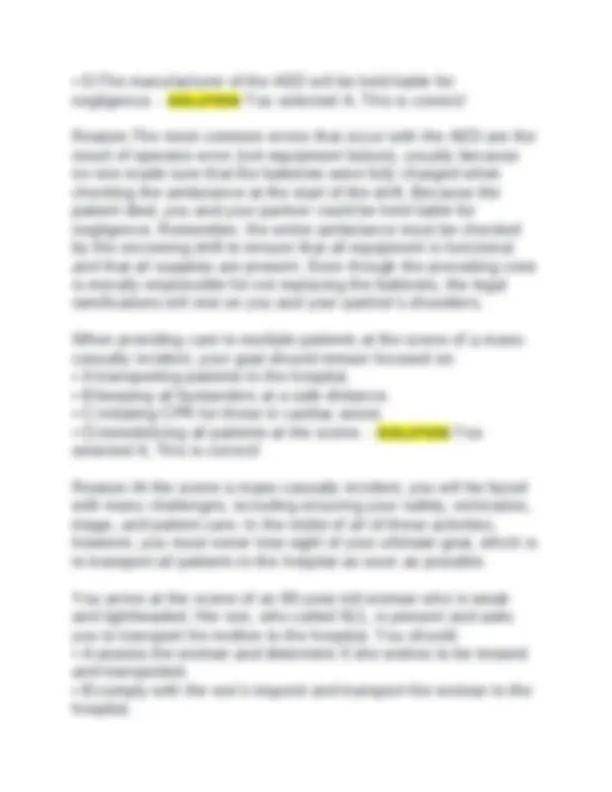Download NREMT Practice Test Bank - Multiple Choice Questions and Answers. and more Exams Nursing in PDF only on Docsity!
NREMT Practice Test Bank - Multiple
Choice Questions and Answers.
Hypoglycemia and acute ischemic stroke can present similarly because:
- A:both oxygen and glucose are needed for brain function.
- B:the majority of stroke patients have a history of diabetes.
- C:the most common cause of a stroke is hypoglycemia.
- D:they are both caused by low levels of glucose in the blood. - SOLUTION • A:both oxygen and glucose are needed for brain function. Reason: Although stroke and hypoglycemia are two distinctly different conditions, their signs and symptoms are often similar. This is because the brain requires both oxygen and glucose to function normally. An acute ischemic stroke is caused by a lack of oxygen to a part of the brain due to a blocked cerebral artery, whereas hypoglycemia (low blood glucose level) deprives the entire brain of glucose. In either case, the patient presents with signs of impaired brain function (ie, slurred speech, weakness, altered mental status). Both conditions may lead to permanent brain damage or death if not treated promptly. When dealing with an emotionally disturbed patient, you should be MOST concerned with:
- A:gathering all of the patient's medications.
- B:safely transporting to the hospital.
- C:whether the patient could harm you.
- D:obtaining a complete medical history. - SOLUTION You selected C; This is correct! Reason: When managing any patient with an emotional or psychiatric crisis, your primary concern is your own safety. Safely
transporting the patient to the hospital is your ultimate goal. If possible, you should attempt to obtain a medical history and should take any of the patient's prescribed medications to the hospital. However, this should not supercede your own safety or interfere with safely transporting the patient. You are at the scene where a man panicked while swimming in a small lake. Your initial attempt to rescue him should include:
- A:rowing a small raft to the victim.
- B:reaching for the victim with a long stick.
- C:throwing a rope to the victim.
- D:swimming to the victim to rescue him. - SOLUTION You selected B; This is correct! Reason: General rules to follow when attempting to rescue a patient from the water include "reach, throw, row, and then go." In this case, you should attempt to reach the victim by having him grab hold of a large stick or similar object. If this is unsuccessful, throw the victim a rope or flotation device (if available). If these are not available, row to the patient in a small raft (if available). Going into the water to retrieve the victim is a last resort. The rescuer must be a strong swimmer because patients who are in danger of drowning are in a state of blind panic and will make every attempt to keep themselves afloat, even if it means forcing the rescuer underwater. How should you classify a patient's nature of illness if he or she has a low blood glucose level, bizarre behavior, and shallow breathing?
- A:Behavioral emergency
- B:Altered mental status
- C:Respiratory emergency
- D:Cardiac compromise - SOLUTION The correct answer is B;
- D:awake and alert and has swallowed a commercial drain cleaner. - SOLUTION You selected D; This is correct! Reason:Activated charcoal adsorbs (sticks to) many ingested substances, preventing them from being absorbed into the body by the stomach or intestines. In some cases, you may give activated charcoal to patients who have ingested certain substances, if approved by medical control or local protocol. Activated charcoal is contraindicated for patients who have ingested an acid or alkali (ie, drain cleaner) or a petroleum product (ie, gasoline), who have a decreased level of consciousness and cannot protect their own airway, or who are unable to swallow. The MOST obvious way to reduce heat loss from radiation and convection is to:
- A:move away from a cold object.
- B:increase metabolism by shivering.
- C:wear a thick wind-proof jacket.
- D:move to a warmer environment. - SOLUTION you selected D; This is correct! Reason:In a cold environment, the body has two ways of staying warm: generating heat (thermogenesis) and reducing heat loss. Radiation is the transfer of heat by radiant energy. The body can lose heat by radiation, such as when a person stands in a cold room. Convection occurs when heat is transferred to circulating air, as when cool air moves across the body's surface. A person standing in windy cold weather, wearing lightweight clothing, is losing heat to the environment mostly by convection. The quickest and most obvious way to decrease heat loss from radiation and convection is to move out of the cold environment and seek shelter from wind. Shivering increases the body's metabolism and is a mechanism for generating heat, not reducing heat loss. Layers of clothing trap air and provide excellent insulation; thus,
layered clothing decreases heat loss better than a single, thick jacket. Conduction is the direct transfer of heat from a part of the body to a colder object by direct contact, as when a warm hand touches cold metal or ice. The most obvious way to decrease heat loss by conduction is to remove your hand from the cold object. A near-drowning is MOST accurately defined as:
- A:complications within 24 hours following submersion in water.
- B:immediate death due to prolonged submersion in water.
- C:survival for at least 24 hours following submersion in water.
- D:death greater than 24 hours following submersion in water. - SOLUTION You selected C; This is correct! Reason:Collectively, drowning and near-drowning are referred to as submersion injuries. Drowning is defined as death after submersion in a liquid medium, usually water. In a drowning, death is either immediate or occurs within 24 hours following submersion. Near-drowning is defined as survival, at least temporarily (24 hours), after submersion. It should be noted, however, that complications such as pneumonia and pulmonary edema can cause death greater than 24 hours following submersion. For this reason, all patients with a submersion injury should be transported to the hospital, even if they appear fine at the scene. A young woman reports significant weight loss over the last month, persistent fever, and night sweats. When you assess her, you note the presence of dark purple lesions covering her trunk and upper extremities. You should suspect:
- A:end-stage cancer.
- B:HIV/AIDS.
- C:tuberculosis.
- D:rheumatic fever. - SOLUTION You selected B; This is correct!
Reason: Many factors can contribute to or result from a submersion injury (eg, drowning, near-drowning). It is not uncommon for a person to experience a spinal injury after diving head first into shallow water, especially if he or she is under the influence of alcohol. When a swimmer panics, he or she initially swallows large amounts of water, resulting in gastric distention. Gastric distention can cause aspiration if the patient regurgitates water during rescue breathing; protect the airway! During the panic phase, the victim expends a tremendous amount of energy (and glucose) from flailing around in the water, possibly resulting in hypoglycemia. Inhaling even a small amount of fresh or salt water can severely irritate the larynx, which sends the muscles of the larynx and vocal cords into spasm (laryngospasm), resulting in airway blockage and hypoxia. A 42-year-old male presents with fever, a severe headache, and a stiff neck. He is conscious, but confused. His wife tells you that he does not have any medical problems and does not take any medications. You should be MOST suspicious for:
- A:acute stroke.
- B:influenza.
- C:meningitis.
- D:tuberculosis. ( - SOLUTION You selected C; This is correct! Reason:Meningitis is an inflammation of the protective coverings of the brain and spinal cord (meninges). Common signs and symptoms of meningitis include fever, headache, neck stiffness (nuchal rigidity), and vomiting. An altered mental status is common in severe cases. Meningococcal meningitis, caused by a bacterium, is the most contagious and potentially fatal type of meningitis. The patient's signs and symptoms are not consistent with acute stroke, tuberculosis (TB), or influenza (the flu). Although fever is common with both TB and the flu, neither
causes neck stiffness. Acute stroke may be associated with a headache, especially a hemorrhagic stroke; however, stroke patients typically do not have a fever. All of the following are signs of gastrointestinal bleeding, EXCEPT:
- A:melena.
- B:hematemesis.
- C:tachycardia.
- D:hemoptysis. - SOLUTION You selected D; This is correct! Reason:Signs and symptoms of gastrointestinal (GI) bleeding include abdominal pain; vomiting blood (hematemesis); the passage of dark, tarry stools (melena); and bright red rectal bleeding (hematochezia). If blood loss is significant, the patient may have signs of shock (eg, tachycardia, diaphoresis, tachypnea, hypotension). Hemoptysis (coughing up blood) is a sign of a pulmonary injury, not GI bleeding. A 24-year-old female presents with a rash to her left leg and swollen, painful knee joints. She tells you that she and her friends returned from a hiking trip in the mountains a week ago. She is conscious and alert with a blood pressure of 112/62 mm Hg, a pulse of 84 beats/min, and respirations of 14 breaths/min. Her symptoms are MOST likely the result of:
- A:Rocky Mountain spotted fever.
- B:tetanus.
- C:Lyme disease.
- D:a localized allergic reaction. - SOLUTION You selected C; This is correct! Reason:The patient's symptoms and her history of a recent hiking trip are consistent with Lyme disease, which was the result of a tick bite. Ticks can carry two infectious diseases: Lyme disease and Rocky Mountain spotted fever. Both are spread through the tick's saliva, which is injected into the skin when the tick attaches itself. The first symptom of Lyme disease, a rash that may spread
- D:dilated pupils. - SOLUTION The correct answer is C; Reason:Heroin is a Schedule I (illegal) narcotic that is typically injected. As with all narcotics, legal or illegal, overdose causes depression of the central nervous system (CNS), resulting in a decreased level of consciousness; bradycardia; hypotension; and slow, shallow (reduced tidal volume) breathing. Hyperpnea (deep breathing) would not be present in a patient who overdosed on a narcotic. In a narcotic overdose, the pupils are typically constricted (miosis). Barbiturates, such as phenobarbital, are also CNS depressants and cause the same symptoms seen with narcotic overdose. The patient's pupils, however, are typically dilated (mydriasis), not constricted. When caring for any patient with a decreased level of consciousness, your primary concern should be the:
- A:potential for airway compromise.
- B:patient's blood glucose level.
- C:possibility of a spinal injury.
- D:possibility of a drug overdose. - SOLUTION You selected A; This is correct! Reason:Altered mental status could be caused by a high or low blood glucose level, drug overdose, or head injury, among other causes. Furthermore, the possibility of a spinal injury should be considered if the patient was injured. However, your primary concern should be the status of the patient's airway. Patients with a decreased level of consciousness are at risk for aspiration if vomiting occurs. Unless spinal trauma is present or the patient is breathing inadequately (eg, fast or slow rate, shallow breathing [reduced tidal volume]), place him or her in the recovery position to facilitate drainage if vomiting occurs. Remember this: no airway, no patient!
A 16-year-old, 125-pound male ingested a bottle of aspirin approximately 20 minutes ago. Medical control orders you to administer activated charcoal in a dose of 1 g/kg. How much activated charcoal should you administer?
- A:54 g
- B:60 g
- C:51 g
- D:57 g - SOLUTION You selected D; This is correct! Reason: First, you must determine the patient's weight in kilograms (kg). Either of the following formulae can be used to convert pounds to kilograms: Formula 1: weight (in pounds) ÷ 2. = weight in kg. Formula 2: weight (in pounds) ÷ 2 - 10% = weight in kg. On the basis of the above formulae, a 125-pound patient weighs 57 kg. Using formula 1, the equation is as follows: 125 (weight in pounds) ÷ 2.2 = 56.81 (57 [rounded to the nearest tenth]). Using formula 2, the equation is as follows: 125 (weight in pounds) ÷ 2 = 62.5 (63 [rounded to the nearest tenth] - 6.3 (10% of 63) = 56.7 (57 [rounded to the nearest tenth]). Since the drug order is for 1 g/kg, you should administer 57 g of activated charcoal to your 125-pound patient. Which of the following is the MOST significant finding in a patient with a severe headache?
- A:Pain in both legs
- B:Chest discomfort
- C:Unilateral weakness
- D:Abdominal tenderness - SOLUTION You selected C; This is correct! Reason: Unilateral weakness (weakness on one side of the body) is a clinically significant finding in a patient with a headache because it could indicate a stroke (ischemic or hemorrhagic). Abdominal, chest, and leg pain are not common complaints
applying warm blankets, and allowing the patient's body temperature to rise gradually and naturally (passive rewarming). If the patient is moderately or severely hypothermic, you should not try to rewarm him or her actively (placing heat on or into the body). Rewarming too quickly may cause a fatal cardiac dysrhythmia, such as ventricular fibrillation (V-Fib). Active rewarming may also cause rewarming shock, a condition in which the blood vessels dilate when heat is applied to the body, resulting in significant hypotension. For these reasons, active rewarming should only be performed in the controlled setting of a hospital. You respond to a grocery store where a 39-year-old man reportedly experienced a seizure. When you arrive at the scene, a clerk begins to escort you to the patient. She tells you that the man stopped seizing about 5 minutes ago. If the patient truly experienced a seizure, you will MOST likely find that he:
- A:has a slow heart rate.
- B:is fully conscious and alert.
- C:is not breathing and is cyanotic.
- D:is confused and disoriented. - SOLUTION You selected D; This is correct! Reason: Most seizures are followed by a postictal phase, in which the patient is unresponsive at first and then gradually regains consciousness. In most cases, the postictal patient appears dazed, confused, or disoriented; in some cases, he or she is combative. The postictal phase typically lasts from 5 to 30 minutes. During the seizure, the patient is often not breathing or is breathing inadequately; however, when the seizure stops, breathing usually resumes. You will also find that most postictal patients are tachycardic; this is the result of an adrenalin surge that occurs during the tonic-clonic phase of the seizure.
You are called to a local park for an ill person. It is a hot day and the humidity is high. When you arrive, a bystander directs you to the patient, a young male who is semiconscious. His skin is flushed, hot, and moist. Your FIRST action in the management of this patient should be to:
- A:begin rapid cooling measures.
- B:ensure an open airway.
- C:administer high-flow oxygen.
- D:move him to a cool area. - SOLUTION You selected D; This is correct! Reason:Your first action in a heat-related emergency is to move the patient to a cooler environment. Once you have moved the patient to a cooler place, you should begin your assessment and treat the patient accordingly. Remember, you must FIRST prevent further harm to the patient. A known diabetic female is found unresponsive. Her respirations are rapid and shallow; her skin is cool, clammy, and pale; and her pulse is rapid and weak. Which of the following would BEST explain the likely cause of her condition?
- A:Failure to take insulin
- B:Insulin overdose
- C:Excessive eating
- D:High blood sugar - SOLUTION The correct answer is B; Reason:The patient has classic signs of insulin shock, a condition caused by a low blood glucose level (hypoglycemia). Common causes of insulin shock include insulin overdose (accidental or intentional), failure to eat (or not eating enough), and excessive exertion. The patient's symptoms are not consistent with diabetic ketoacidosis (DKA), a condition that results from a high blood glucose level (hyperglycemia). Signs of DKA include deep, rapid breathing with a fruity or acetone breath odor (Kussmaul respirations), and warm, dry skin. Unlike insulin shock, which can
- B:move him to a supine position by rotating the entire upper half of his body as a single unit.
- C:stabilize his head as you remove it from the water and open his airway by tilting his head back.
- D:grab him by his clothing, remove him from the pond, and assess for breathing and a pulse. - SOLUTION The correct answer is B; Reason:After safely reaching a drowning victim, you should first turn him to a supine position by rotating the entire upper half of the body as a single unit; protect the cervical spine as you do this because a spinal injury cannot be ruled out. Open the patient's airway, without manipulating the neck, and begin rescue breathing while still in the water. Float a buoyant backboard under the patient, secure him to it, and remove him from the water. After removing the victim from the water, assess for a pulse. If the victim is pulseless, begin CPR, dry him off, and apply the AED as soon as possible. Which of the following patients with diabetes is the BEST candidate for oral glucose?
- A:A confused patient who has cool, clammy skin
- B:A semiconscious patient with pale, clammy skin
- C:An unresponsive patient who took too much insulin
- D:A confused patient with suspected hyperglycemia - SOLUTION You selected A; This is correct! Reason:Oral glucose is indicated for patients with diabetes who are in insulin shock (hypoglycemic crisis), or for any patient with symptomatic hypoglycemia (as documented by glucometer). The patient must be conscious and alert enough to be able to swallow the glucose, which comes in a tube of gel. If the patient is unresponsive or otherwise unable to swallow the glucose, you should provide rapid transport, providing the appropriate airway management en route, and consider an ALS intercept.
A 40-year-old woman presents with widespread hives that she noticed about 45 minutes after taking penicillin. She is conscious and alert and denies difficulty breathing. Her breath sounds are clear to auscultation bilaterally, her vital signs are stable, and her oxygen saturation is 94%. She tells you she is allergic to wasps and has an epinephrine auto-injector. You should:
- A:assist her in administering epinephrine via her auto-injector.
- B:give high-flow oxygen and administer 100 mg of Benadryl.
- C:give supplemental oxygen and transport her to the hospital.
- D:advise her that she can probably drive herself to the hospital. - SOLUTION You selected C; This is correct! Reason:The patient is experiencing an allergic reaction, but she is not in anaphylactic shock. Urticaria (hives) is common to all allergic reactions, regardless of severity; however, wheezing and hypotension, which she does not have, are specific to anaphylaxis. Although she carries an epinephrine auto-injector for her allergy to wasps, she was not stung by a wasp. Furthermore, the absence of wheezing and hypotension negates epinephrine administration. Give supplemental oxygen (in a concentration sufficient to maintain an SpO2 of greater than 94%) and transport her to the hospital. Because it can take up to an hour for signs of a severe allergic reaction to manifest, the patient should not drive herself. Diphenhydramine (Benadryl), an antihistamine, is an appropriate drug based on her presentation; however, it is not typically carried on a BLS unit. Furthermore, the correct dose is 25 to 50 mg. Immediately following a generalized motor seizure, most patients are:
- A:hyperactive.
- B:confused.
- C:apneic.
- D:awake and alert. - SOLUTION You selected B; This is correct!
Reason:Components of the primary assessment for both responsive and unresponsive patients include assessing and managing the airway and assessing and managing circulation, which includes controlling any major bleeding; assessing the rate, regularity, and quality of the pulse; and assessing the color, condition, and temperature of the skin. When restraining a violent patient, you should make sure that:
- A:the patient is restrained using maximal force.
- B:at least two EMTs restrain the patient.
- C:consent for restraint has been obtained from a family member.
- D:someone talks to the patient during the process. - SOLUTION You selected D; This is correct! Reason:If a violent patient needs to be restrained, you must ensure the presence of at least four people (one per extremity). One of the EMTs should continuously talk to the patient to explain what is happening, even if the patient is not listening. Restraint is a last resort used to protect the EMT as well as the patient. Consent is not needed from a family member prior to restraining the patient. Just enough force to effectively restrain the patient is all that is required to prevent causing unnecessary injury. Immediately following a generalized seizure involving tonic-clonic activity, most patients:
- A:have a slow heart rate because of cardiac depression during the seizure.
- B:are unresponsive but gradually regain consciousness.
- C:experience prolonged apnea and require positive-pressure ventilations.
- D:return to a normal level of consciousness but cannot recall the event. - SOLUTION You selected B; This is correct!
Reason:Most generalized (grand mal) seizures last 3 to 5 minutes and are followed by a lengthy (5 to 30 minutes) period called the postictal phase, in which the patient is unresponsive at first but gradually regains consciousness. During the seizure itself, the nervous system releases excess adrenaline (epinephrine); therefore, tachycardia, even after the seizure has stopped, is common. Apnea is common during a seizure; however, breathing usually resumes after the seizure has stopped. Many patients are tachypneic following a seizure; this is the body's attempt to eliminate excess carbon dioxide that accumulated in the blood during the seizure. Unlike grand mal seizures, petit mal seizures (also called absence seizures) can last for just a fraction of a minute, after which the patient fully recovers immediately with only a brief lapse of memory of the event. Which of the following organs are contained within the right upper quadrant of the abdomen?
- A:Liver and gallbladder
- B:Stomach and gallbladder
- C:Liver and spleen
- D:Liver and stomach - SOLUTION You selected A; This is correct! Reason:The liver and gallbladder lie within the right upper quadrant of the abdomen. Most of the stomach is within the left upper quadrant, as is the entire spleen. You respond to a baseball field for a person who was struck by lightning. When you arrive, you see one patient who appears confused and is ambulatory; a second patient who is conscious, sitting on the ground, and holding his arm; and a third patient who is supine and motionless. After requesting additional responders, you should:
- A:assess the motionless victim and perform CPR and defibrillation if necessary.

